
I was surprised by how often the question “now how did you choose to go there?” came up whenever I mentioned our summer plans to travel to Scandinavia. I’d been interested in visiting for years. My curiosity was particularly piqued when we flew through the Stockholm airport en route to Croatia back in 2008: the tourism bureau’s photographs on the walls, the Ikea-like organization, and the reindeer pelts in the stores captured my imagination about this far north place. When I was looking up flights earlier this year, seeing where one could get to for the least money, I spotted some $300 RT direct flights from Oakland to Stockholm on Norwegian and the search was really on. Those were for March, and it cost us more to fly in June, but we didn’t think twice.*
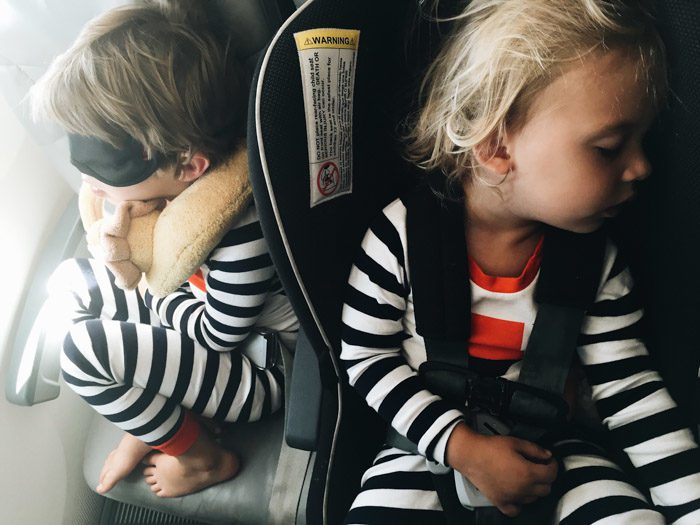
*Though we maybe should have—one issue with planning this way is it doesn’t take account the costs once you arrive somewhere, and Scandinavia is expensive!
If you visit the Stockholm tourist guide, they welcome visitors by describing the city in these terms: “Modernity meets tranquility. Trend-setting restaurants and vibrant nightclubs next to idyllic archipelago. Welcome to a city where it is easy to breathe—and to feel your pulse.” The copywriter got it so right! The neighborhood or district we’d based ourselves in, Södermalm, would certainly fall to the trend-setting/modern side of that description, but I gather it’s been that way for a while. In the spectrum of cool, it has the feeling of “arrived,” with all of its hip young families and established restaurants, rather than “up and coming.” It also felt easy to breathe there. Alongside cafes and shops and restaurants was a lot of green. Parks and vistas—playgrounds—around every corner. And this sort of counterbalance was felt throughout our stay in Stockholm.
As usual, I’ve put far too much detail into the travelogue and it’s a million words long, but I didn’t want to forget anything about this amazing city! If anyone has suggestions to add for future visits, I’d love to hear them in the comments.
First, the flight: The red-eye flight went incredibly well. It still feels a bit like a game of chance getting on a plane with two kids so young. Someone could throw up, throw a fit, or just decide to pull an all-nighter, but we got incredibly lucky. The flight from Oakland left around dinner time so after some food and few movies, we changed the kids into PJs and they went to sleep. We brought Skyler’s car seat along expressly for the long-haul flights, planning to check it at the Left Luggage desk in Stockholm and thought it was worth it for the peace of mind.
Ten or so hours later, we were there. And after a very (very, very) long wait getting through passport control, we dropped off the car seat and bought tickets from a kiosk for the 20-minute train (Arlanda Express) into the city center.
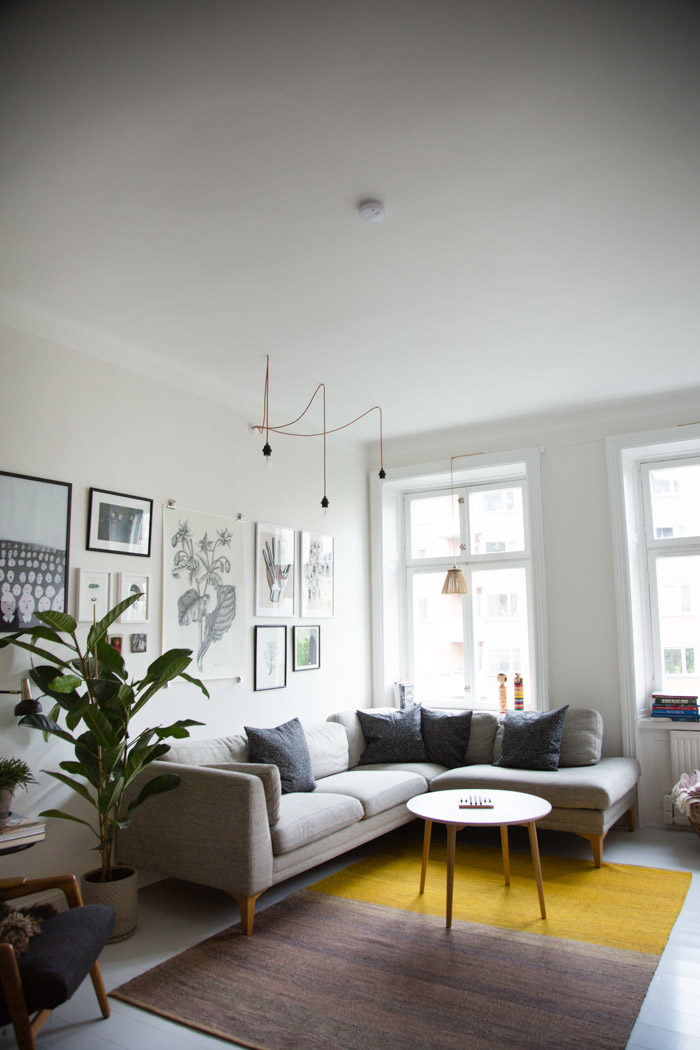

We had done very little planning in advance of this trip, but we had reserved an apartment through AirBnB for our first five nights in Stockholm.
And the apartment was amazing. The owner, we learned, designed a lot of the textiles in the house and everything was just so beautiful and it was such a pleasure to be in. Staying in someone’s home really came to feel like a valuable part of our stay: everything is like a clue into the culture, from the coffee pot to the washing machine, from the way the shoes are kept at the stairs to the way the bed is made with two duvets. And throughout our stay in Scandinavia, we had fun spotting all of the (almost always customized) Ikea furniture.
The kids found their way to the toys immediately, which gave us a little extra time to plot out the last hours of the day. (We wanted to get out in the light and get our body clocks adjusted as soon as possible.) There was a bunk bed, which was so exciting for them, along with toys that happened to be for two children their ages. Skyler found her way directly to the baby and the pram, while Hudson sat splayed in the fort with picture books across his lap.
And there were loads of beautiful picture books… all in Swedish. Aron and I would both try to figure out what the heck they were about, and make up the story as we turned the pages. It was surprisingly difficult! (Tänk Om or Tia Vilda Hästar, for example.) We agreed that Swedish storylines appear to be much more creative.

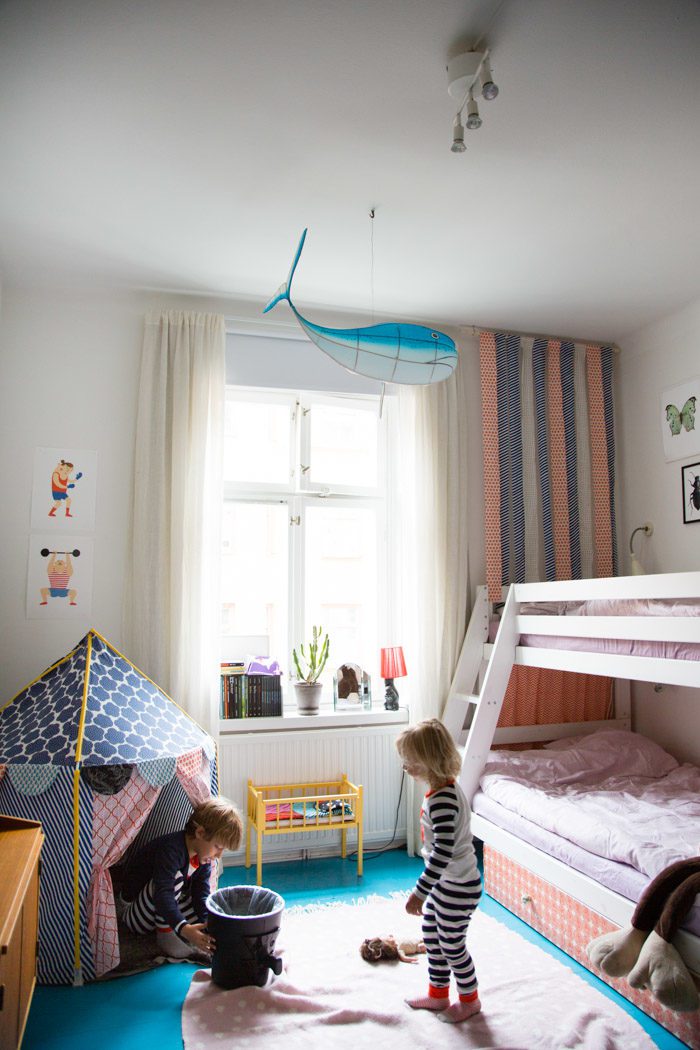

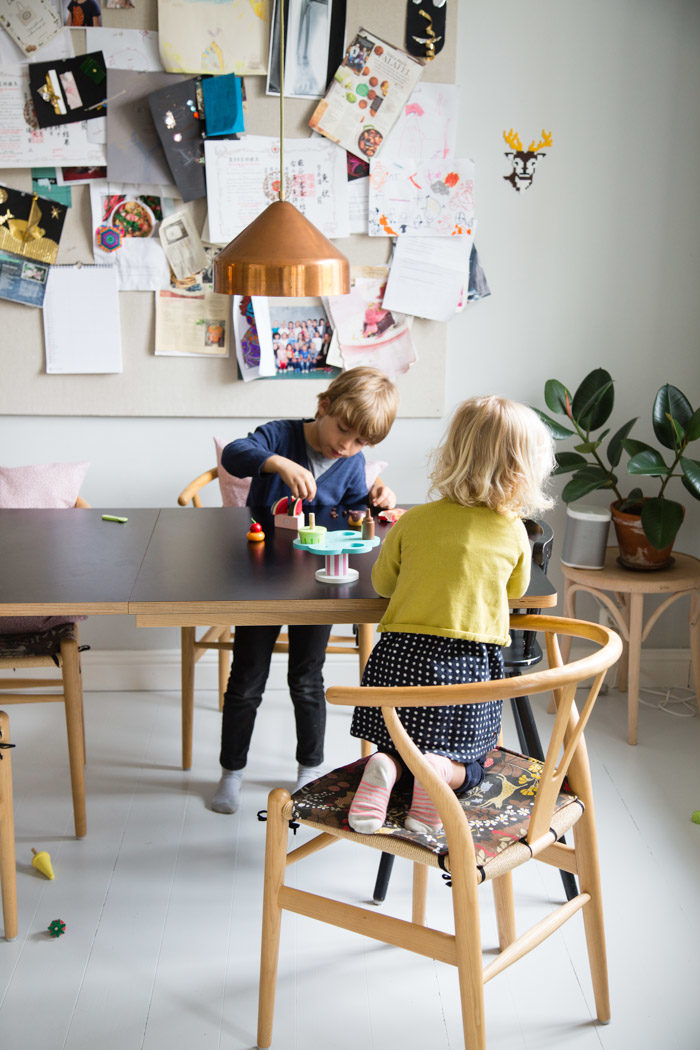
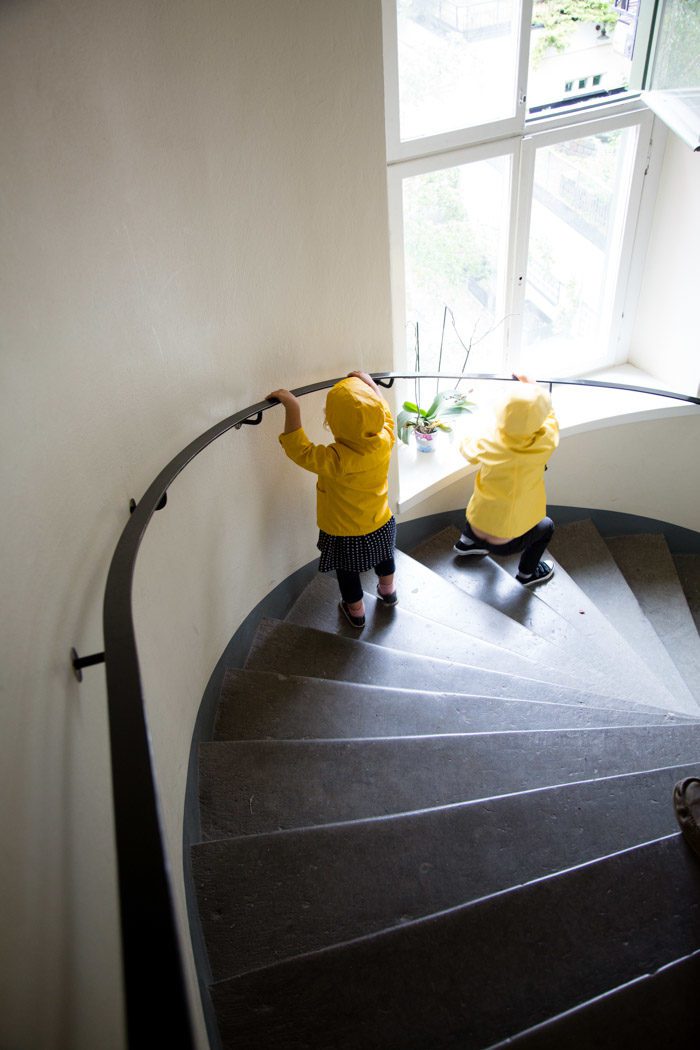
That first day was fairly grey and gloomy. I was happy that, at the last moment, I’d tossed in the kids’ rain jackets and my rubber boots.
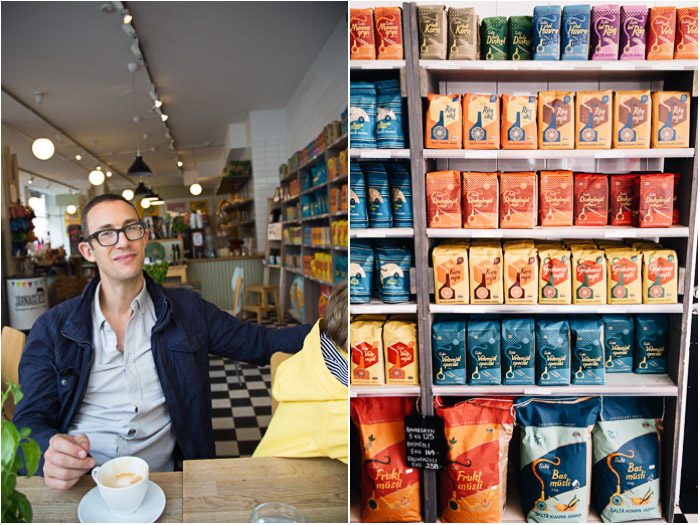
On our first foray out, we only made it around the corner before pausing at Saltå Kvarn, a bakery/cafe/grocery with an incredible array of Müsli and the fragrance of freshly baked bread, to have our first fikabröd.
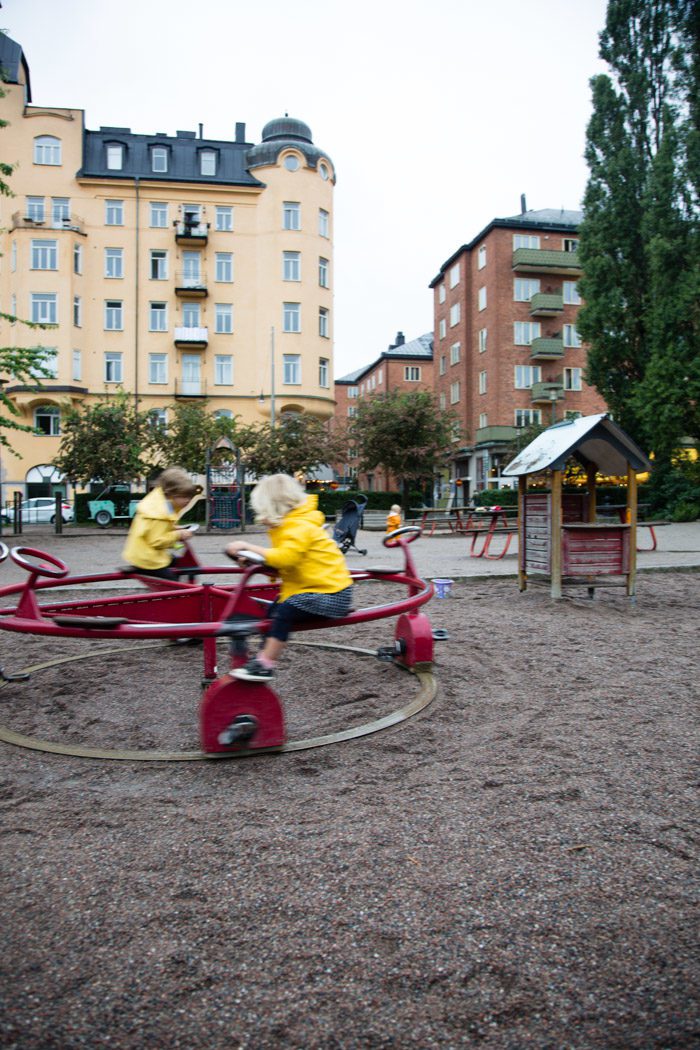
Followed by, no big surprise, a first stop at a playground.
We were a few minutes away from Nytorget, a charming little square bordered by Vitabergs park on one end and rows of cute cafes and brunch restaurants on the other sides. Gilda’s Room, Nytorget 6, and Mississippi Inn, as well as Urban Deli (first recommended to me in a guide shared here)—where we ended up stopping for dinner that first night—are all nearby.
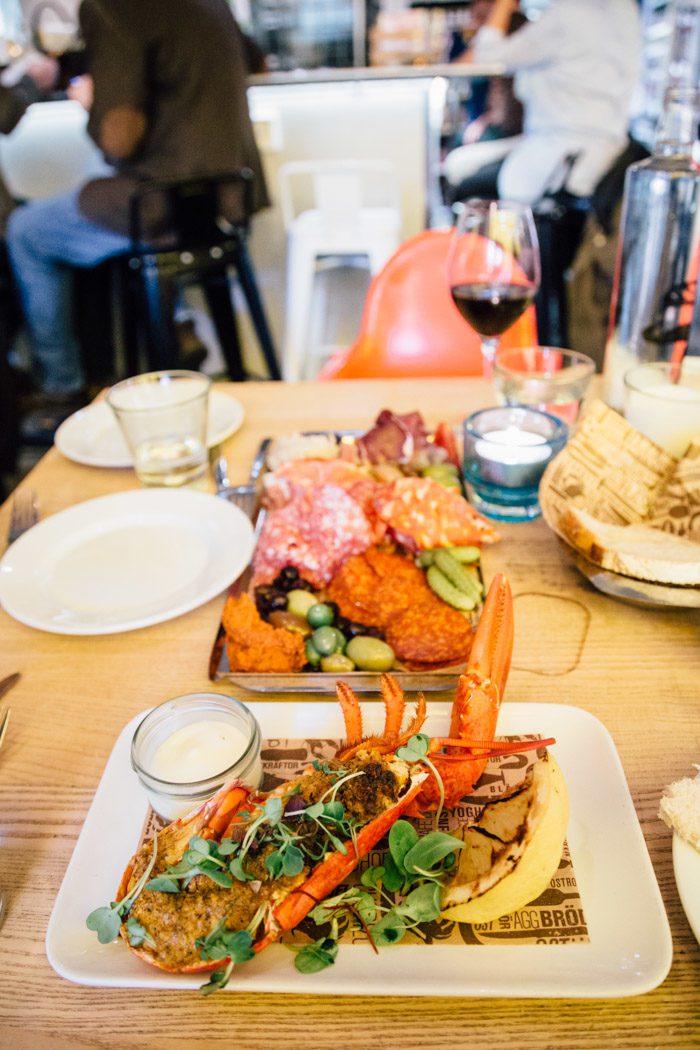
I’d been promised (by myself, mostly) lots of amazing seafood in Scandinavia, so I ordered lobster. It was delicious. We shared that and an incredible plate of charcuterie with the kids. They, by the way, were fading fast by this point and getting pretty wiggly. We had ample coloring books and supplies prepared for distraction, but we didn’t linger long. There was another family seated nearby, but we did note that kids were less likely to be out at the more scene-y dinner spots.
There’s a little grocery attached to the deli as well, so we picked up a few provisions, but it’s a lot like a Dean & Deluca in the states: a very premier selection that will cost you dearly.
It felt so good to go to sleep that night, even as we knew it would likely be a long one—as most first ones abroad are.
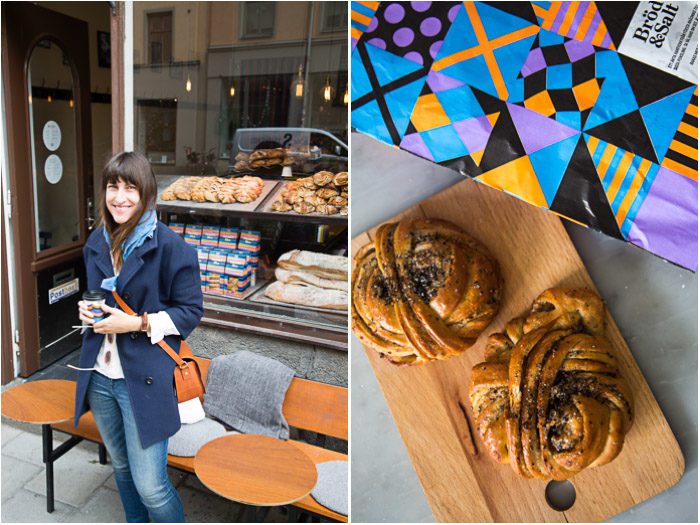
Stockhom is made up of 14 islands and ours, Södermalm, is connected to Gamla Stan, the central old town, to the north by Slussen (a grid of road and rail and a lock that separates the lake Mälaren from the Baltic Sea), and six or seven other islands in other directions. So there’s water everywhere you look.
We were set to cross over to Gamla Stan on this morning, armed with pastries from Bröd & Salt (just around the corner, it became a daily stop—our favorite for cardamom rolls called Kardemummabullar) and a Rick Steves walking tour. We planned our days according to weather forecasts once we arrived.
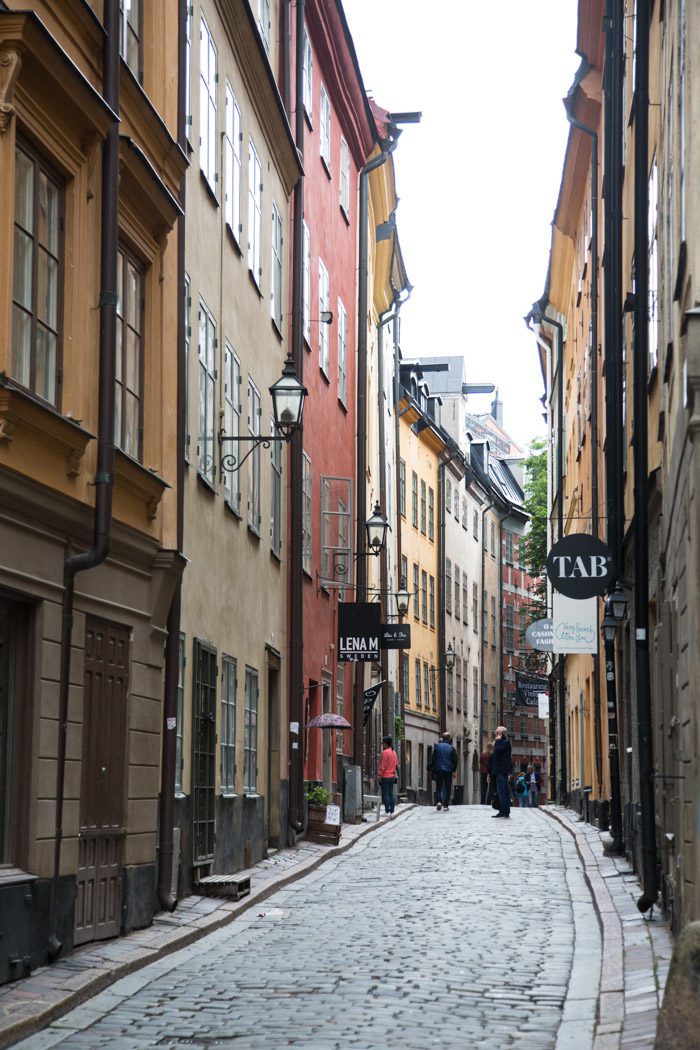
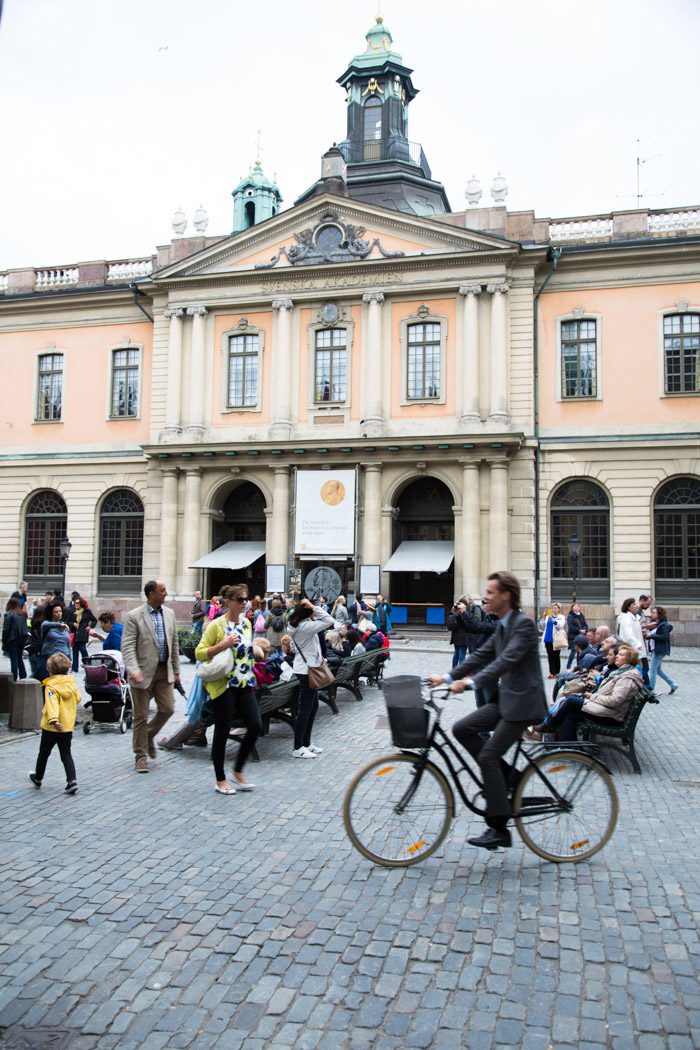
Many of Stockholm’s historic tourist sites are situated in its old town, the Gamla Stan: the Royal Palace, Royal Armory, the Nobel Prize Museum, the Cathedral, and more, but we knew we wouldn’t be spending our time in museums or reading many placards with our two little ones, so I usually look forward to including a walking tour that will still allow us to learn a bit about a city’s history in our itinerary. (I crossed my fingers we might fit in the Fotografiska museum one day, but no such luck—I hear it’s wonderful.)
One day we might find ourselves back in the halls of photographs and antiquities more often.
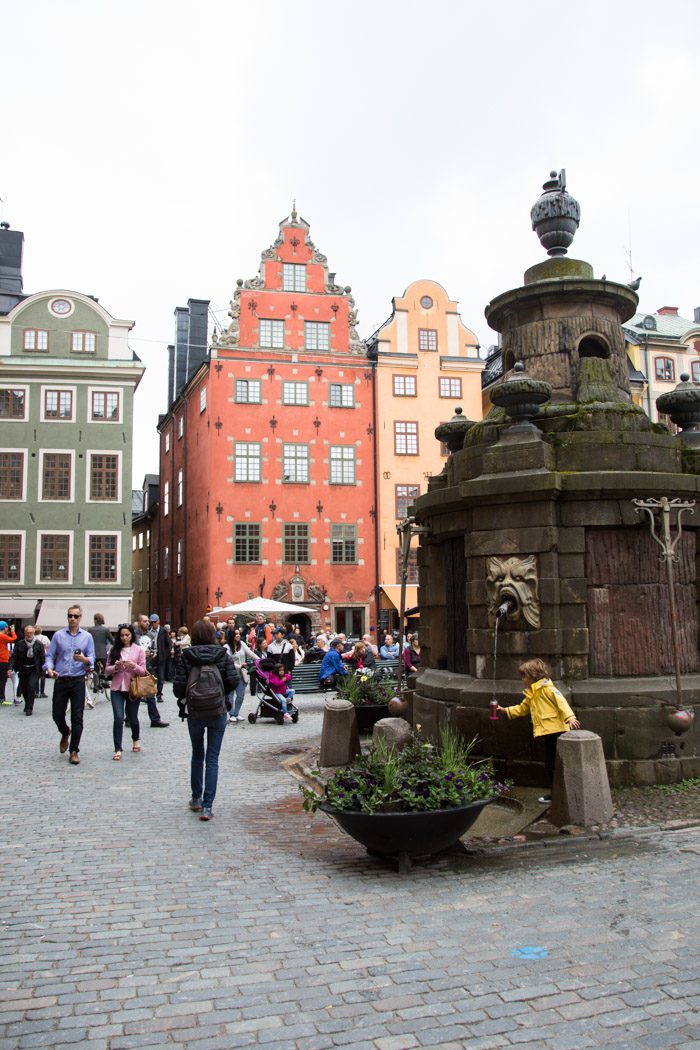
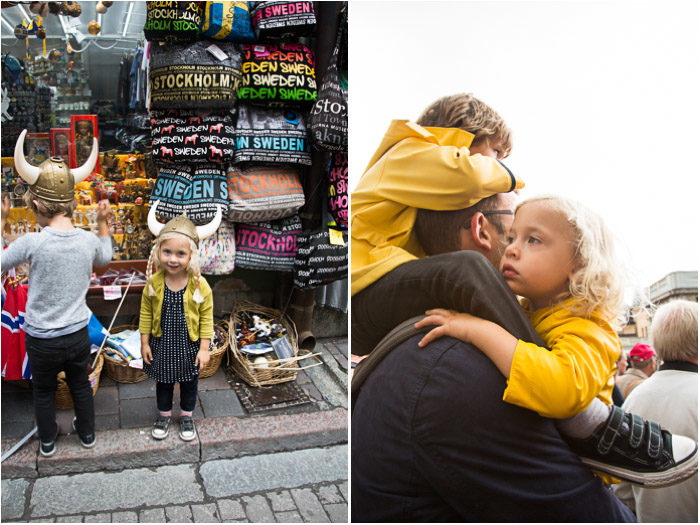
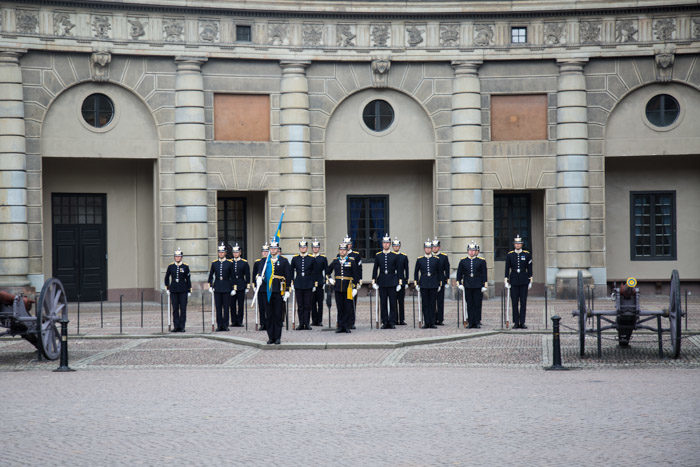
Sweden’s royal family sleeps outside of the city at Drottningholm Palace, but the official royal residence is in Gamla Stan. You can tour the palace, but we were happy to catch the Changing of the Guard around one o’clock that day for a small dose of ceremony.

I also popped into the Royal Gift Shop to browse the book jackets and postcards showing the opulent royal chambers, see which souvenirs were the most unique. (And there were a lot! Like princely outfits and robes and special strawberry jams, and interior design articles based on patterns from the 1600s forward.) We treated the kids to something from the toy section. We found a pair of little wooden race cars that proved very motivating for running about.
We found we could use all the motivation we could find: we had only brought one stroller on this trip, with the idea that Hudson really shouldn’t need one and, if he did, we could more easily carry Skyler. Those of you at a similar limbo point? Bring the second stroller. If we were going to Italy, our strategy might have proven more essential—with the tiny cars and whatnot—but everywhere we went (throughout Scandinavia) we saw locals pushing enormous strollers and almost every staircase was adjusted to accommodate them. Most places expected you to have one, and bus rides around the city are free to anyone with a stroller (whether there’s a child in it or not, I was told).

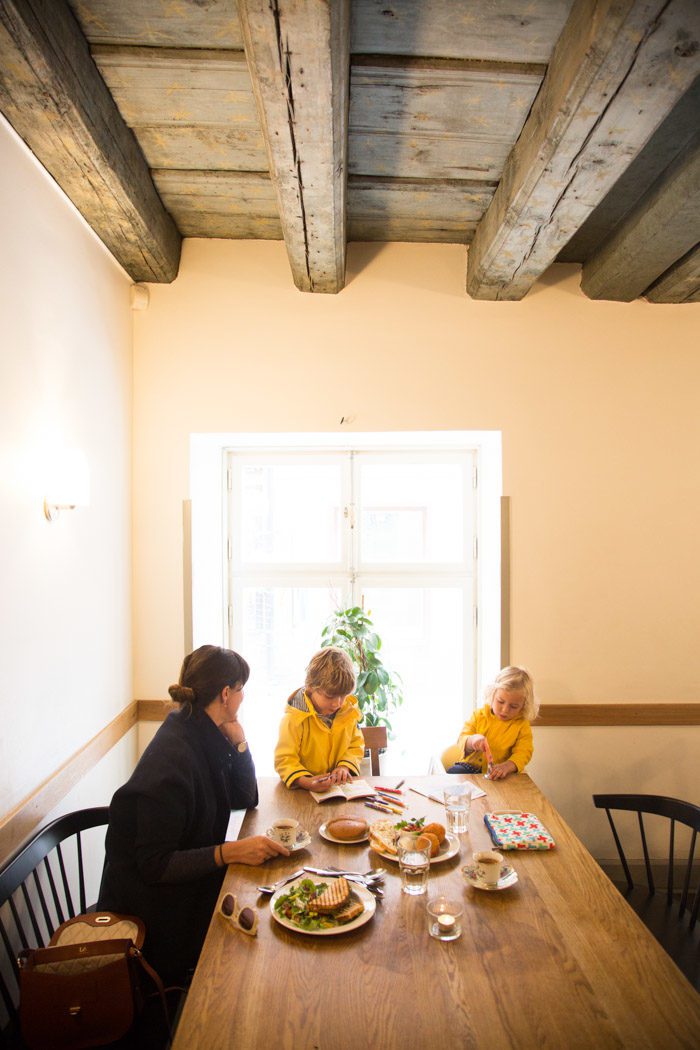
For lunch, we paused inside Grillska Huset cafe off the Stortorget for a quick bite. Something that stood out here to Aron in particular? It was the first place we spotted a giant bowl of butter set out with bread. The robust bread culture here seemed to include the expectation of butter as a right.
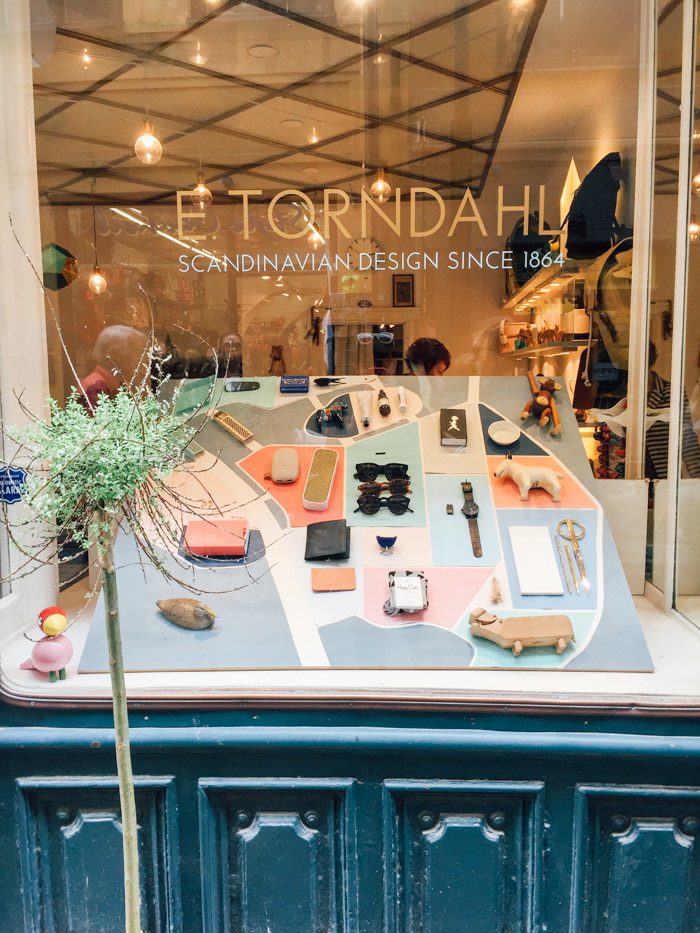
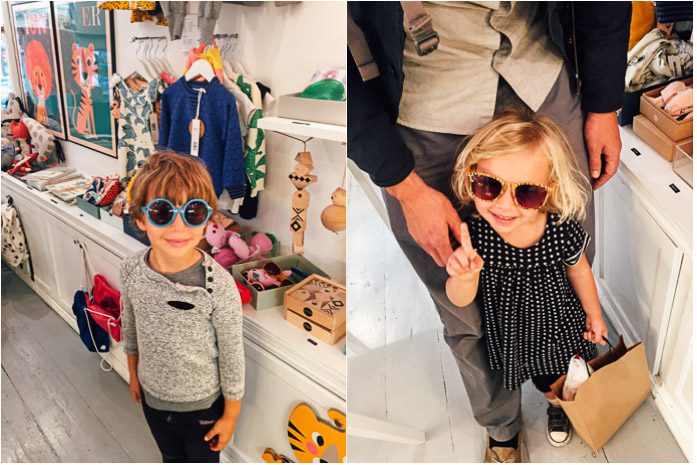
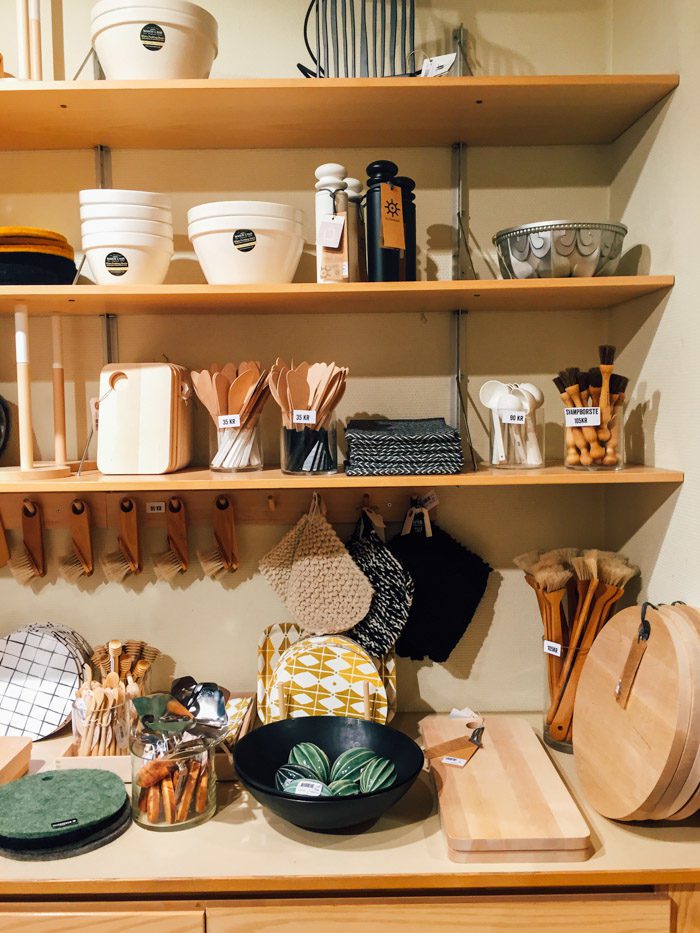
The main thoroughfares of Gamla Stan are crowded with tourists (and a fair share of knick-knacks), but there were also lots of beautiful design shops. A few favorites:
Iris Hantverk (traditional bound brushes and beautiful nordic design), E. Torndahl (a wide range of carefully collected Scandinavian products), Krabat (children’s toys), and I was tempted by the gorgeous rain jackets at Stutterheim, but had trouble justifying the purchase for California weather. As it turns out, I might have really enjoyed having it on our trip (and ended up buying a different one in Copenhagen)!
I could have easily passed the day (and spent far too much money) on the children’s goods alone. If you like brands like Ferm Living and Mini Rodini, you’ll be in good company.
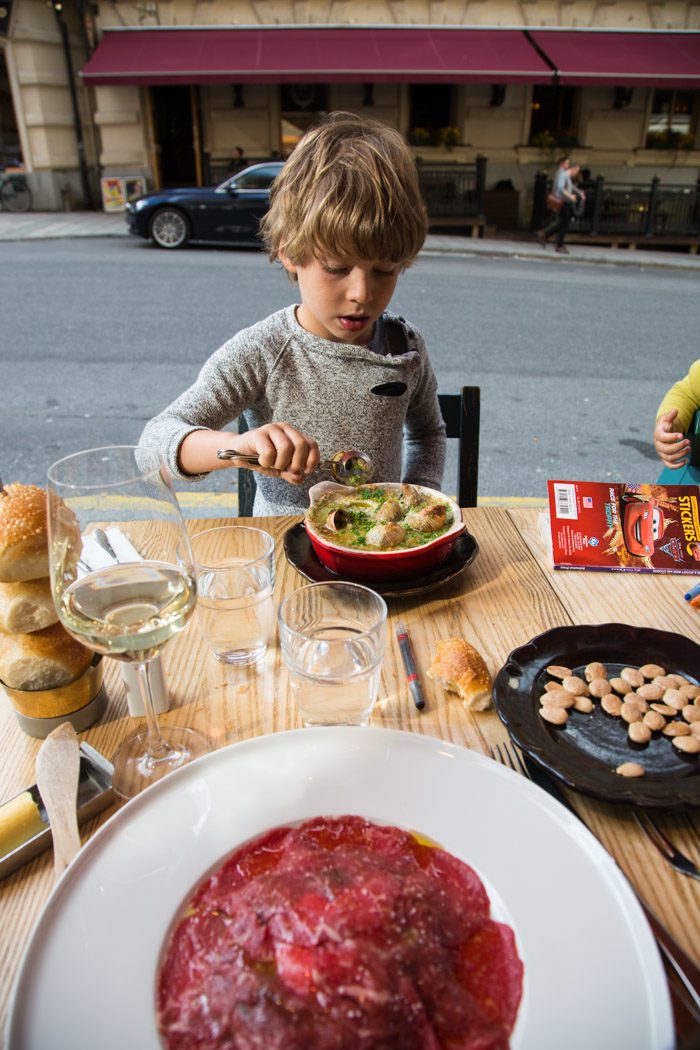
I’d asked a travel concierge to send us suggestions for restaurants before the trip, and we dovetailed between some of their picks and some of our own. I’ve found them to have great ideas (I wish we’d had time to fit in all of the activities they’d suggested) and it’s nice to have someone else just make a dining choice from all the options out there, but they don’t tailor their recommendations to kids—which did result in some slightly challenging but funny scenarios. For dinner tonight, they’d made us reservations at Rolf’s Kok on the upper edge of Norrmalm, “Swedish classics in a contemporary setting.” Sidenote: reservations were generally for inside tables. We requested to sit outside as it was such a lovely night and had a delicious dinner.
It was across town, and we hesitated about going so far, but it turned out to be a good way to get our bearings and better understand how the city fit together. We took an Uber there and then walked back—stopping to ride every lion statue along the mostly pedestrianized Drottninggatan (Queen Street) on the way home. We passed a lot of good shopping—more of the department store ilk—on this walk.
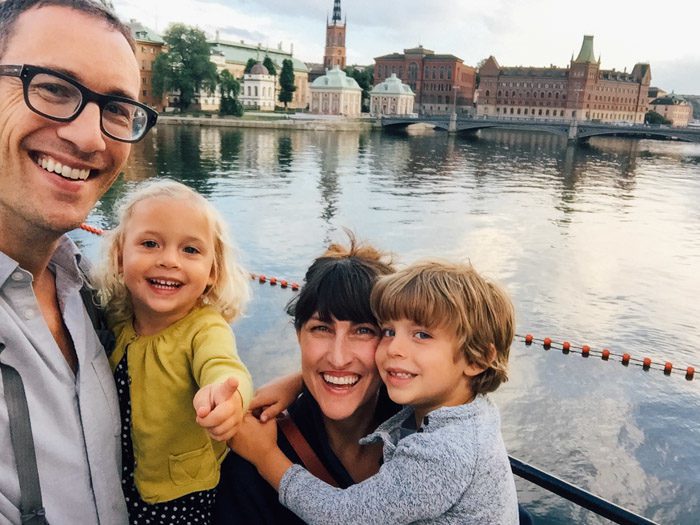
The next morning, Aron downloaded the public transportation app and we made ourselves a bit more familiar with the bus system (we didn’t use the underground T Bana on our visit, but it’s surely a great way to get around, too) on our way to Djurgården to visit the Vasa museum and Skansen.
Djurgården is Stockholm’s green island—royal land since the fifteenth century—reachable by foot, ferry, tram, or bus. Many national museums are there, as well as the Gröna Lund amusement park and the ABBA experience.
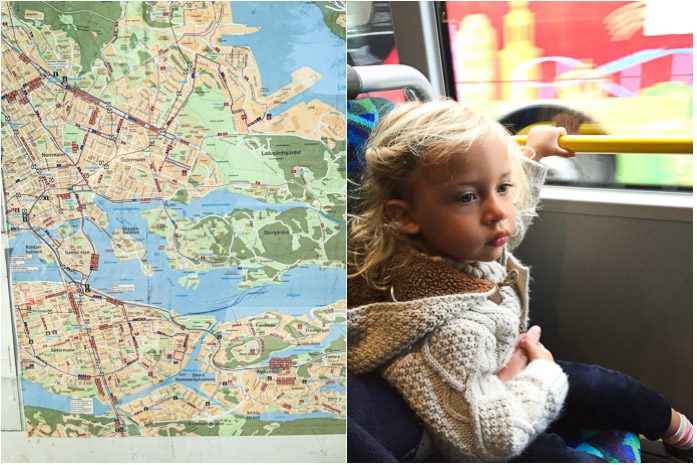
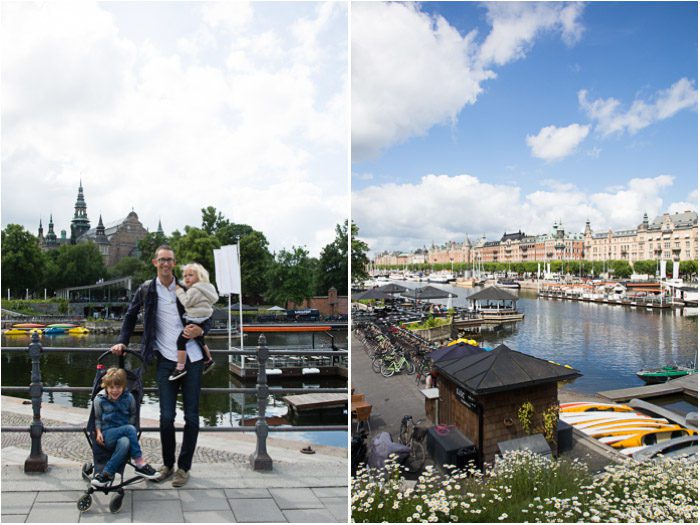
It’s recommended in many guidebooks to rent bicycles or use this as a point of departure for kayaking or GoBoats, and it looked like it would be a wonderful activity (especially with older kids, though I did see a few child seats).

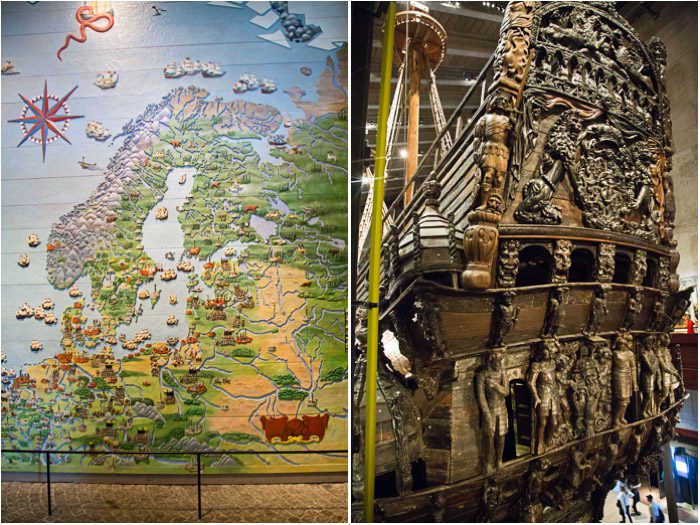
Visiting the Vasa, a preserved seventeenth-century ship that sank in the middle of Stockholm in 1628, salvaged 333 years later in 1961, was the activity most frequently recommended to us by others who had been to the city.
And with good reason. For almost 500 years, the ship has been carefully restored, and the results are incredible. The sheer size of the ship is breathtaking, but what’s amazing is to learn how the ship was uncovered and brought to light.
We stopped in the gift shop on the way out and bought a translated copy of a children’s book about the Vasa’s history, originally written and illustrated in 1964. It has since become one of Hudson’s favorite books. If you’re going with someone his age, you might consider stopping at the gift shop first and reading it before going inside.
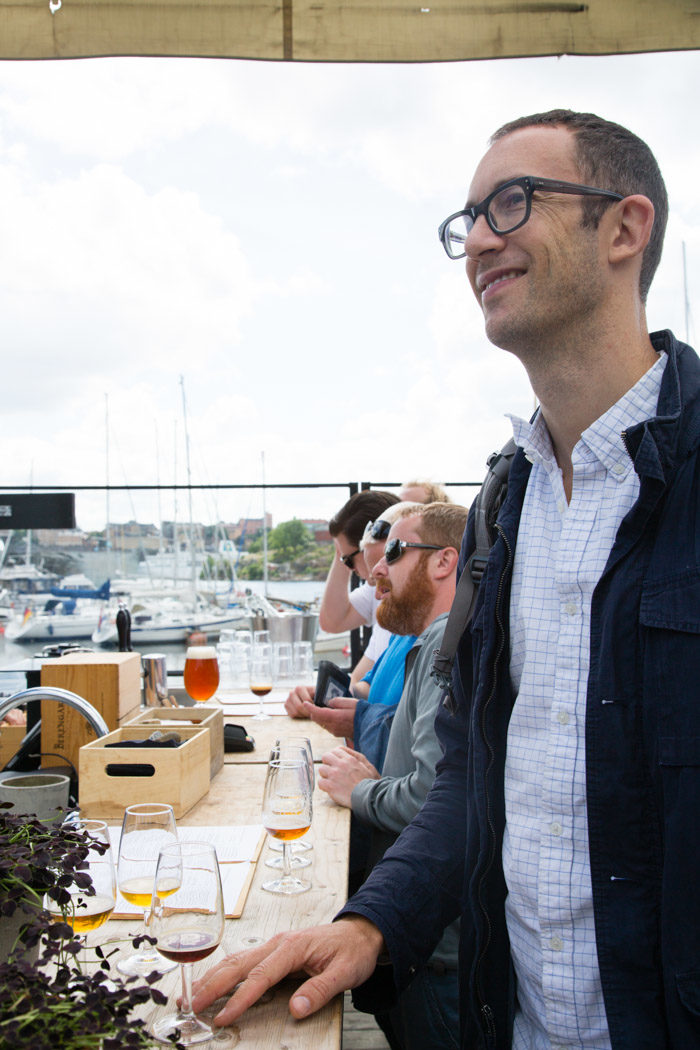
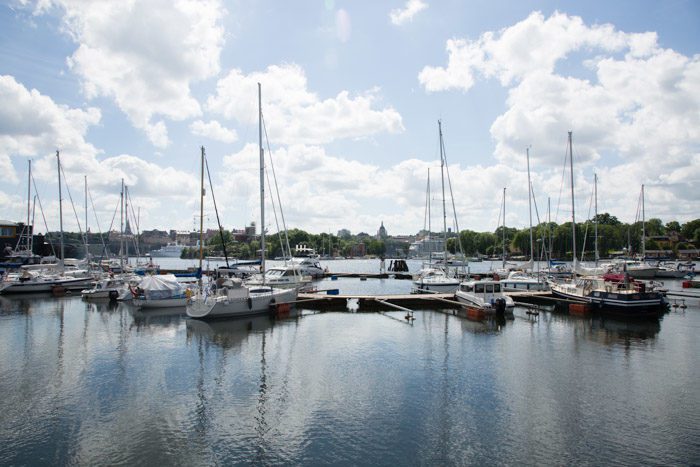
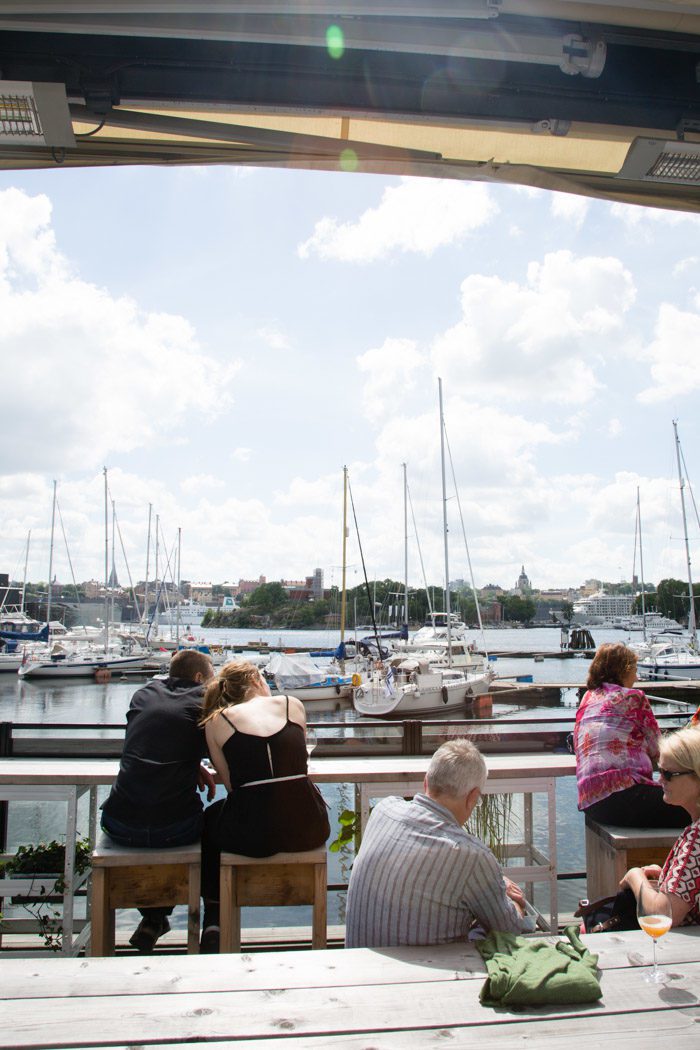
We had some lackluster hot dogs at the snack bar outside (there’s a nice restaurant that may have been tastier), and then Skyler fell asleep in her stroller just as we were passing The Spirit Museum. The sun was out and the timing seemed too perfect to pass it by, so we handed over the iPhone to Hudson for a video game and ordered two glasses of beer.
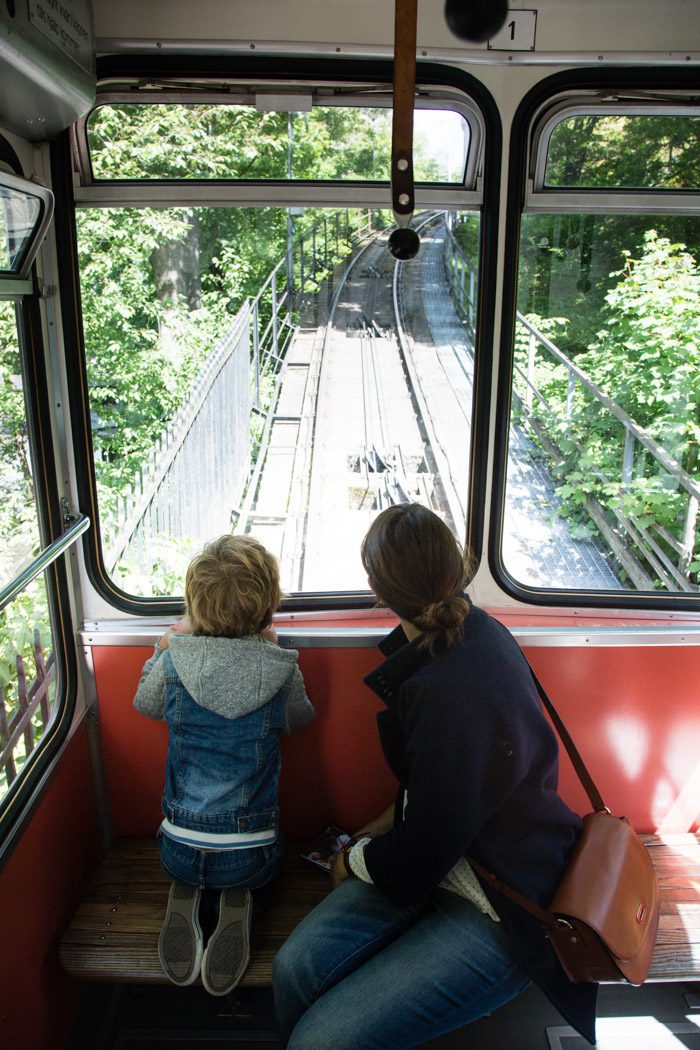
Afterward, we continued to Skansen, the first open-air folk museum—and also the Stockholm zoo. We wandered it for hours and you could easily pass a day here: 150 farms and dwellings from different parts of the country were disassembled and transported here, so it’s a bit like a mini-Sweden… with views overlooking Stockholm.

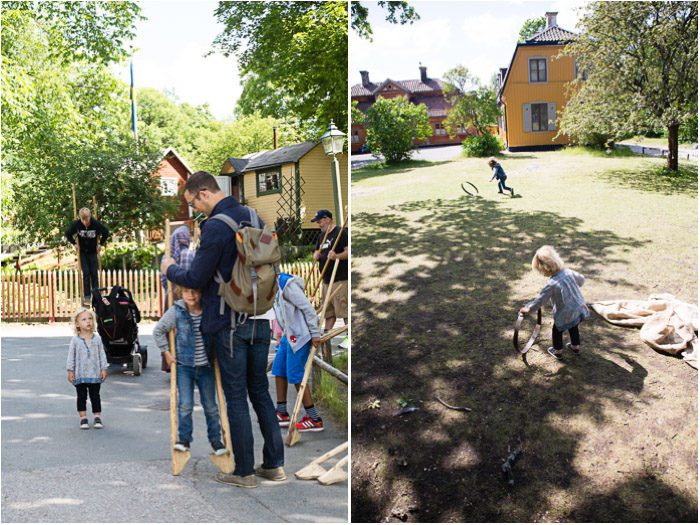
There was something really refreshing about playing the old games—like stilt-walking, and hoops—with the kids.


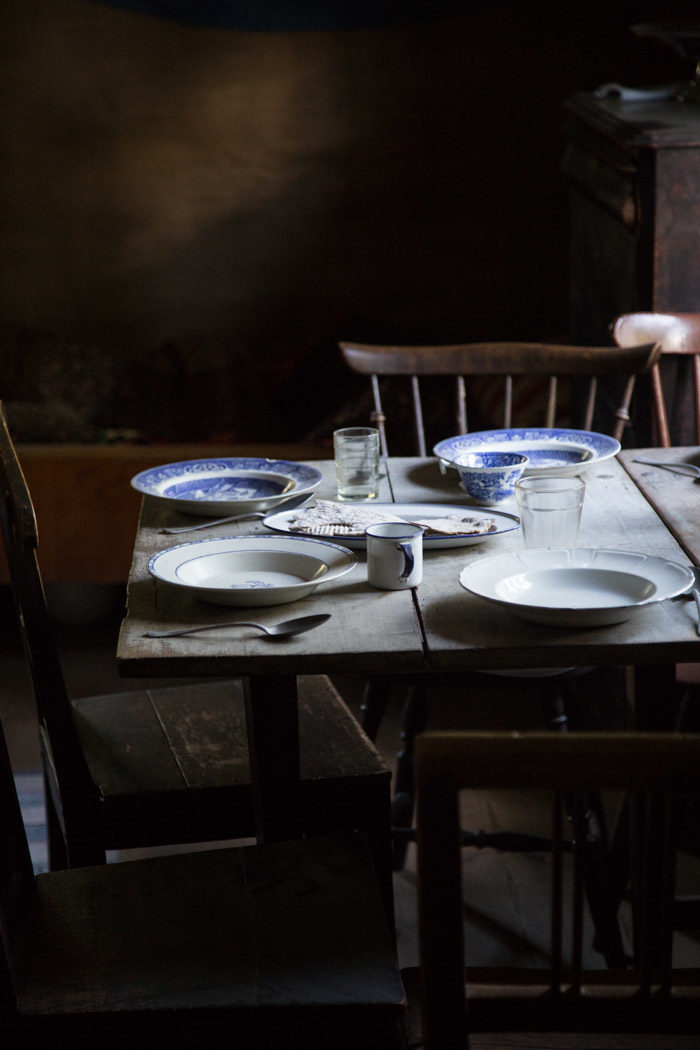
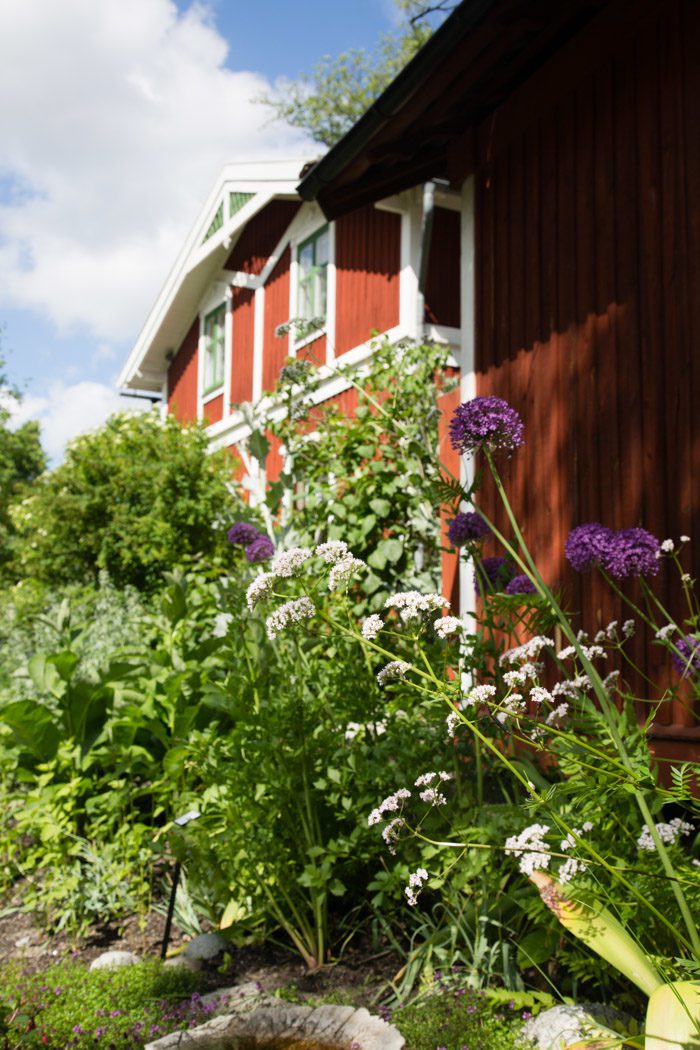
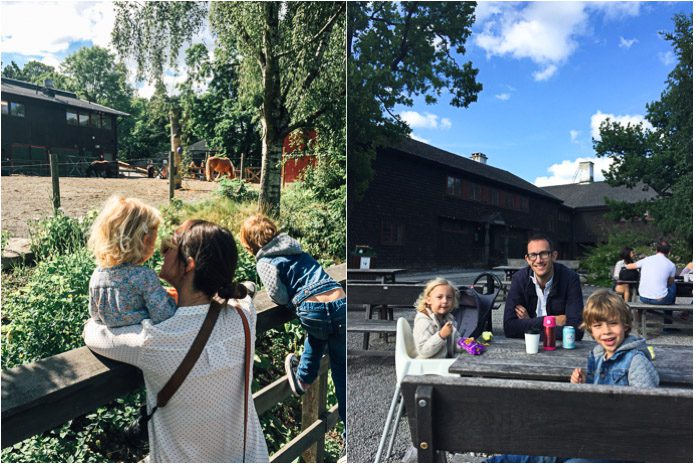
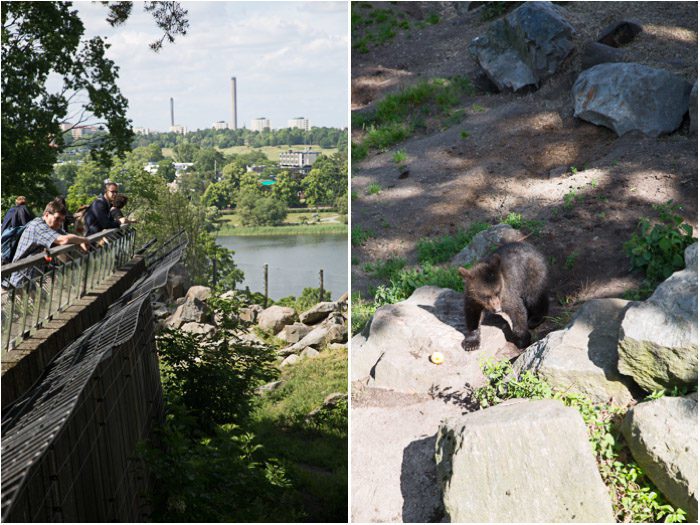
One of the highlights was spotting bear cubs in one of the enclosures! We also loved getting to see reindeer and wolves—the focus is on native Scandinavian animals.
We actually ran out of time before we could make it to the children’s zoo; but there was something for everyone.
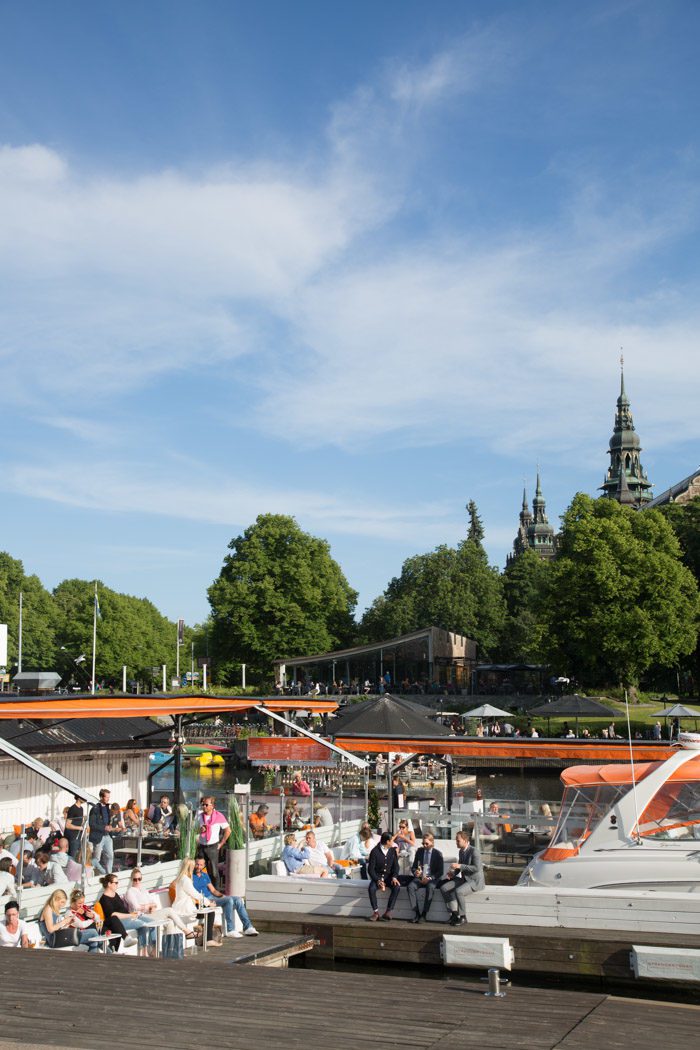
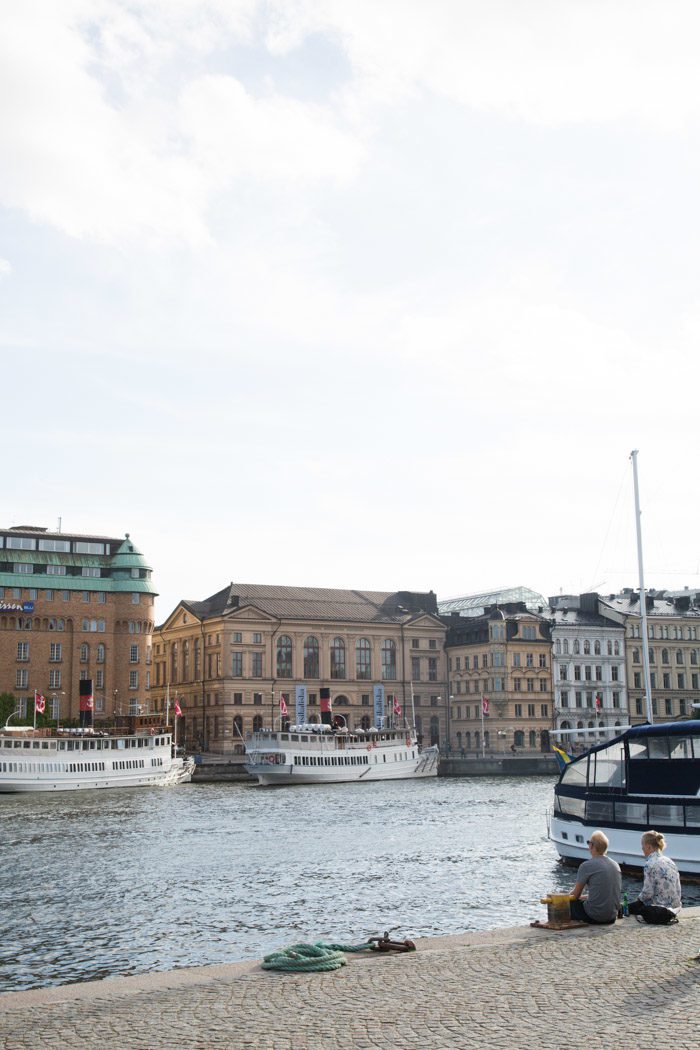
We walked back off Djurgården to a busy scene: the weather was so beautiful and you could imagine how celebratory summers must be here.
One thing I haven’t mentioned yet is the light. It would stay light until around 11pm each night. We were there just a few days before Midsummer, so it was maximum daylight—about 18 hours. And maximum “golden hour.” The afternoons were beautiful.
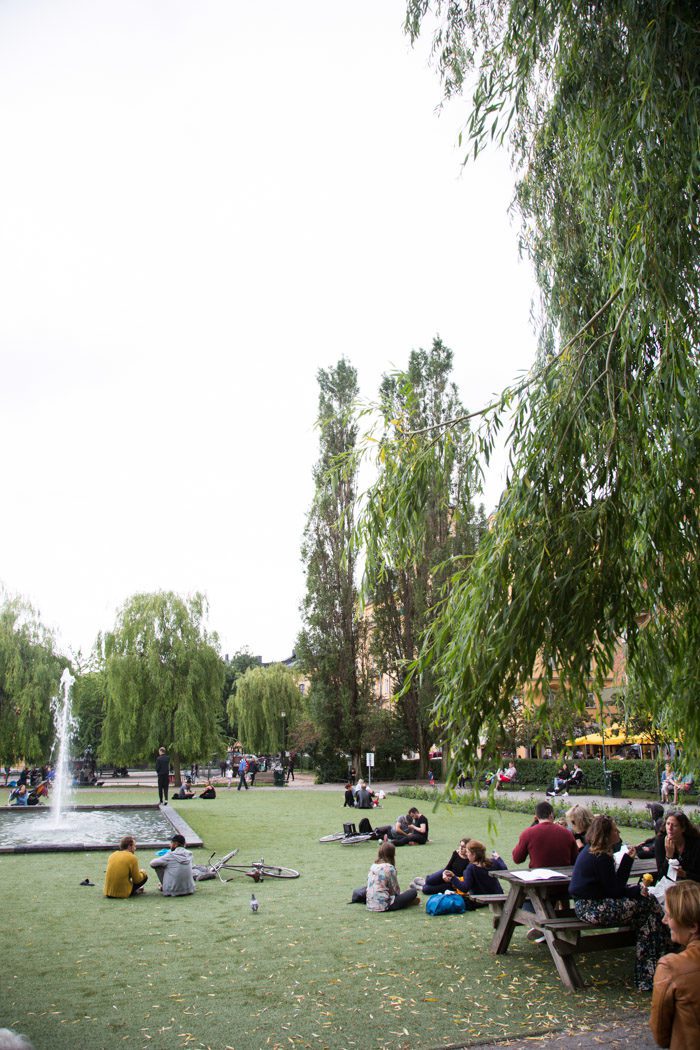

The light and the time change also amounted to a tendency to stay up later and sleep in longer. And our jet lagged little ones took a lot of naps-on-the-go.
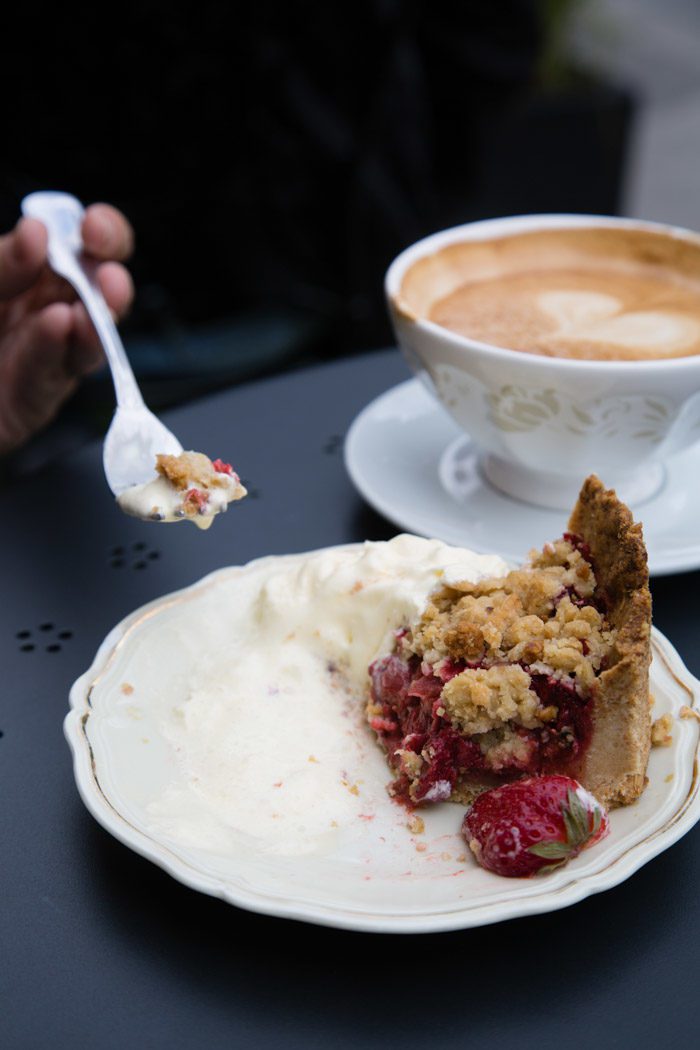

That night’s dinner was also in Norrmalm, at Kött & Fiskbaren—a restaurant with a pub-like vibe, long tables, scuffed wood floors, and display cases of meat and fish. It reminded us a lot of Marlow & Sons in Brooklyn, an impression aided by the Brooklyn Lager on tap. Again we felt like it wasn’t a natural family spot, but the kids were great and it had a fun, noisy ambiance that drowned out any of their antics.
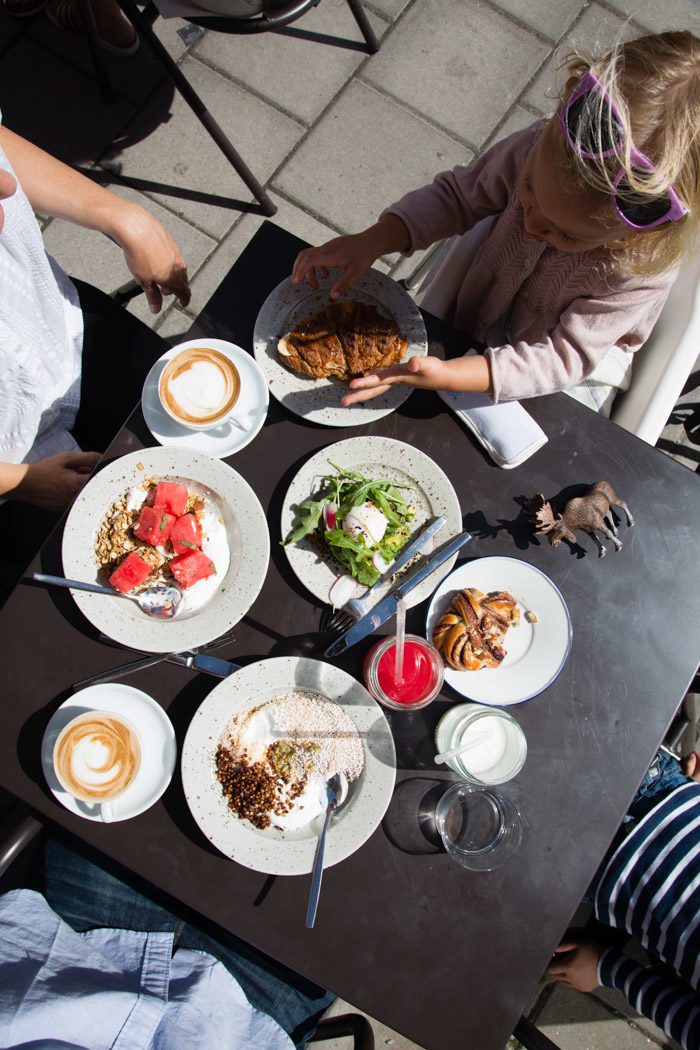
The next day was forecasted to be the sunniest, so we planned an excursion out to the archipelago. Visiting the islands off of Stockholm had become a bit of a priority of mine. I had this vision of rocky, isolated skiffs with little red houses that I was excited to see realized. Oddly it became one of the central logistical puzzles in our planning. We really wanted to immerse ourselves in the classic archipelago experience and spend at least one night on an island, preferably two, rather than take a hit-the-highlights day trip.
In general, I knew I wanted at least two of our nights to be something like that—a small island or village stay—and the options were almost overwhelming. Staying in the Stockholm archipelago would put us there over Midsummer, a major holiday for Swedish families, and not only were most rentals booked up, we were a bit concerned about figuring the logistics on holiday schedules. In the end, we decided simply to take a ferry out far enough that we’d get beyond the majority of day trippers, but still come back that evening.
We started with breakfast at Pom & Flora, and then caught a ride to the port.
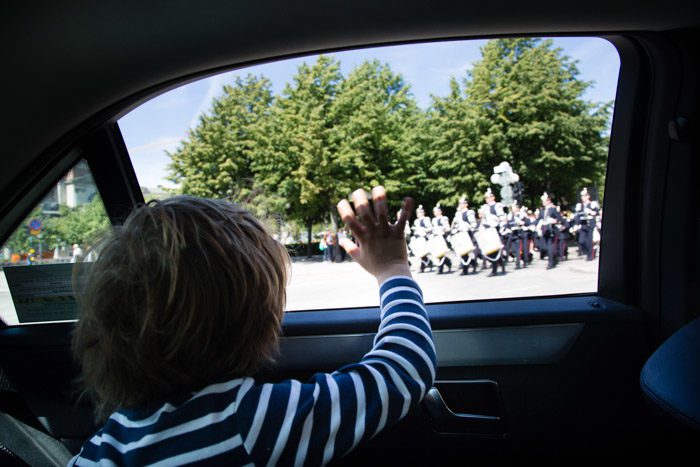
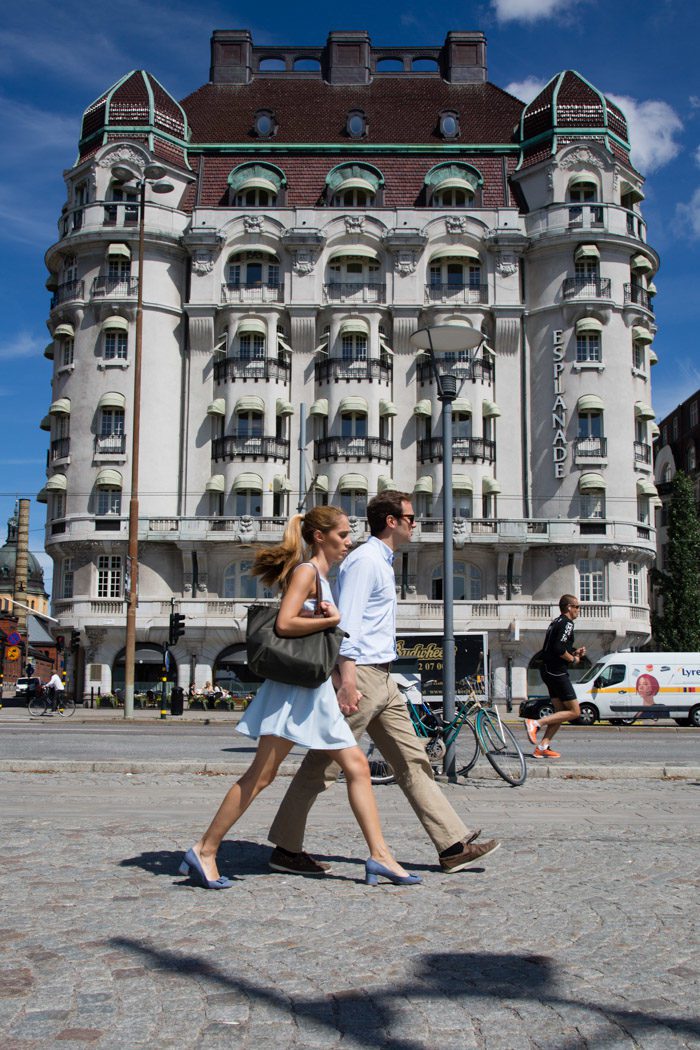
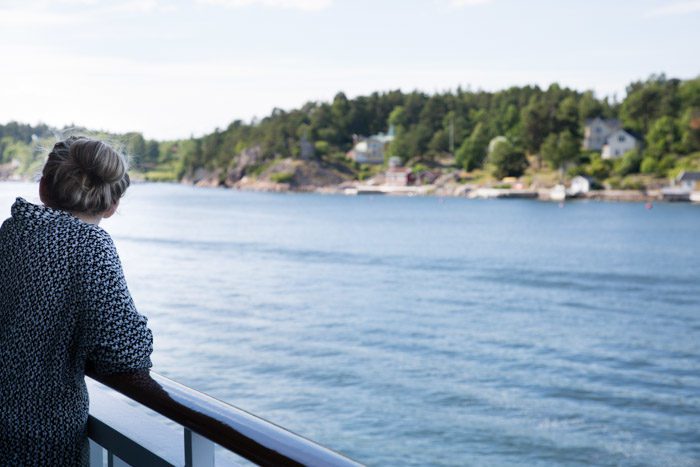
The Stockholm Archipelago website has a good rundown of all the islands, and the Archipelago Foundation led us to transportation links for Grinda, our selected endpoint.
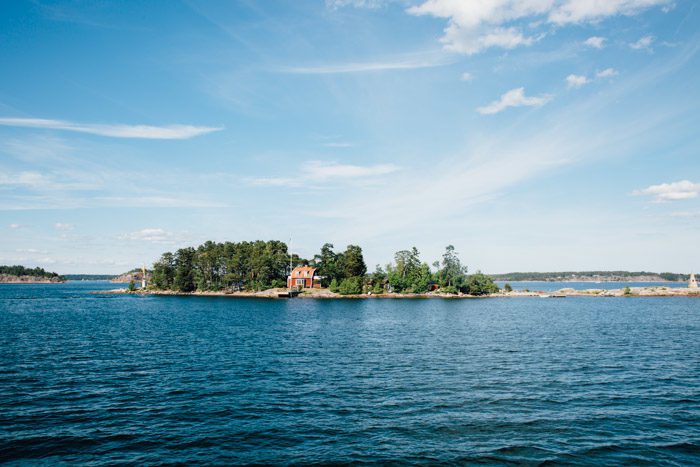

We’d chosen a fairly direct route to the island—only a few stops—but were a bit disappointed to find the usual vessel out of commission, replaced with a smaller one with almost exclusively indoor seating. Still, the views along the way were beautiful. It took us just over an hour to get to Grinda and, once there, some people seemed to basically take ten steps off the boat and stop to spread out. The point was clearly just to get away and enjoy nature. But you could walk about 15 minutes into the island for some more interesting spots to swim, as well as to visit a restaurant, boat harbor, and inn.
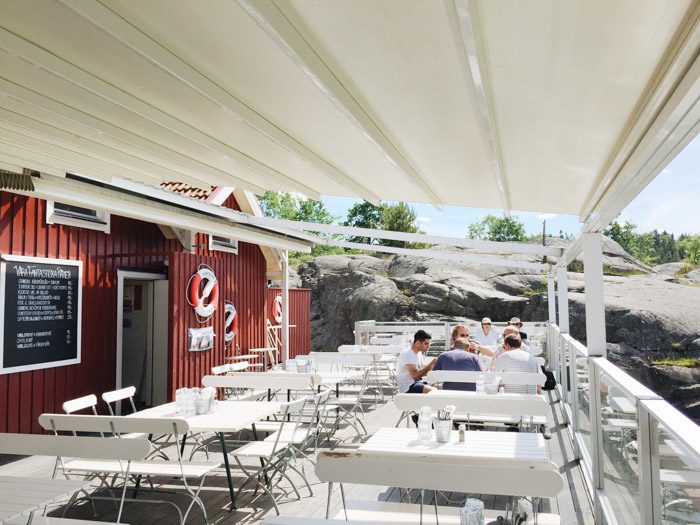

We opted for fish sandwiches (fried fish topped with raw salmon) in the harbor while Skyler napped in the stroller.
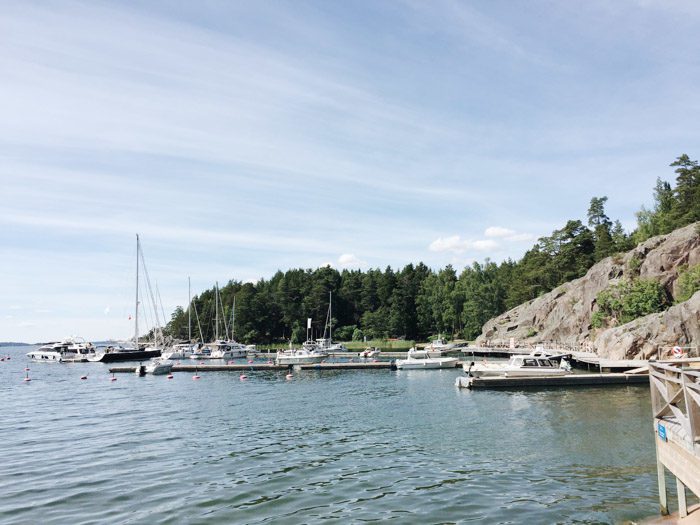
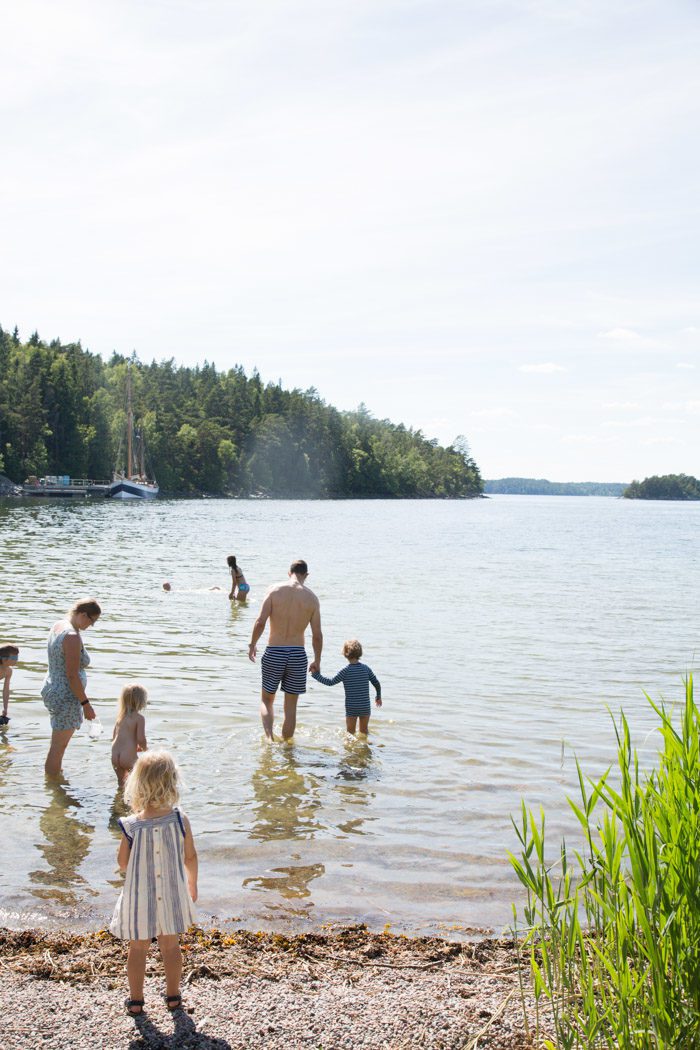
The little beach just beyond the dock opened up to a shallow bay and you had to walk a long way out to really swim. Aron and Hudson were committed and made their way out while I made it about waist-deep and Skyler just dipped her toes. It was very, very cold water!
But fortunately, it was a warm, sunny day, and it was exciting to think we were in the Baltic Sea. We were sorry when our time was up so quickly!
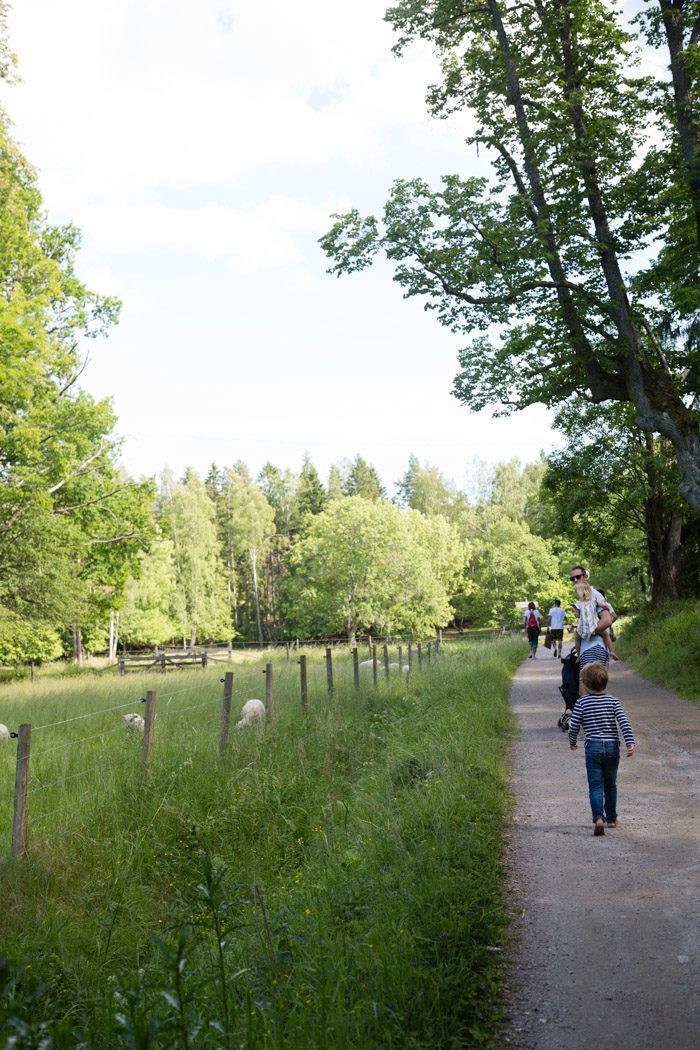
In fact, Aron spotted a large boat approaching the dock and started running onto it, simply asking “going to Stockholm?” when he realized it was time to go. I thought it was odd that the boat was early (timetables seem to be pretty strictly observed here), but didn’t inquire further until we saw a second boat pull up: ours. Unfortunately, there wasn’t time to disembark and change boats, so we stayed on the first one—the slow boat.
We probably wouldn’t have chosen to make the mistake (we lost a little time we’d planned for browsing Östermalm), but it actually was a more interesting and picturesque route home. I felt like it was on that slower, return trip that we got our best sense of what an escape into the archipelago would really be like.
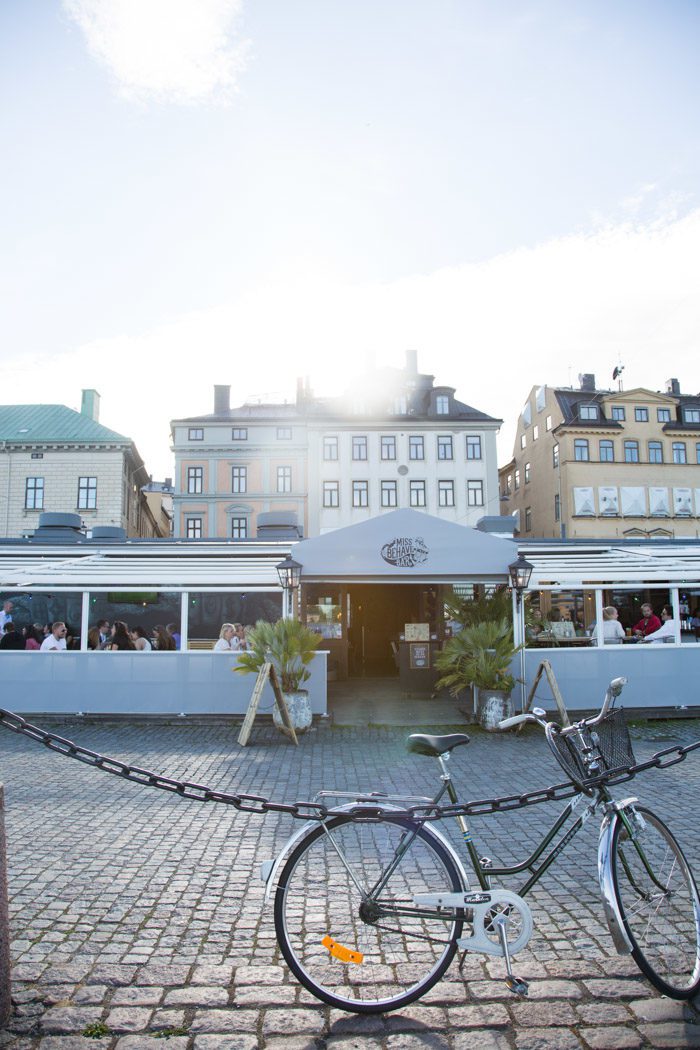
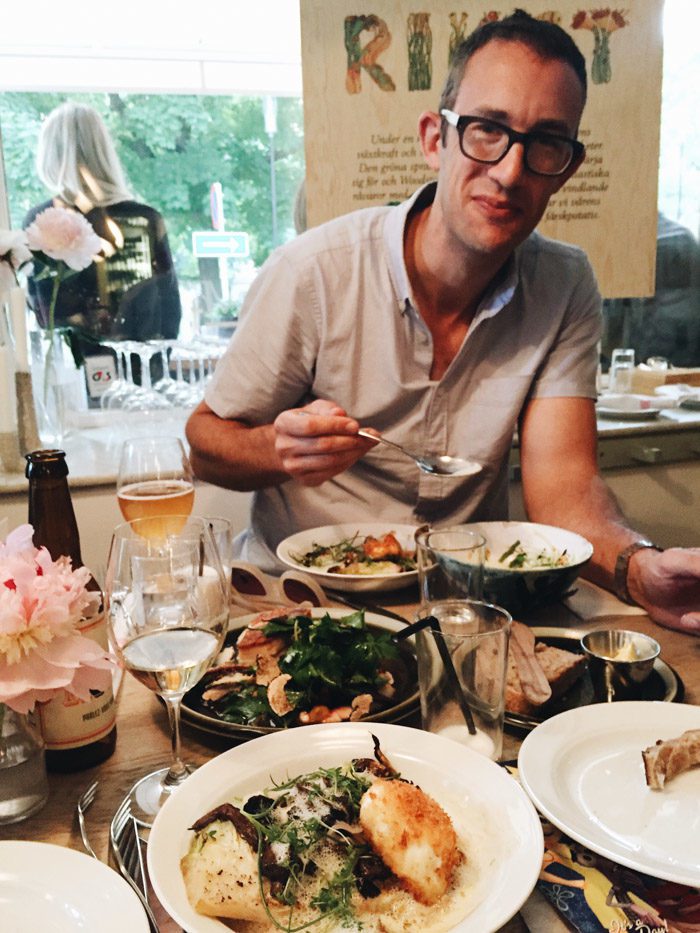
That night’s dinner reservation was set for us at Woodstockholm, with an ever-changing thematic menu focused on organically produced food and wine. We’d passed by it—in Södermalm’s Mosebacke torg—the night before when it was closed and didn’t fully appreciate that it might be a bit high-brow for our kids. Community-style tables and bar seats are generally a signal that we should move along (where does the high chair go?). But the hosts were as welcoming as anywhere else and seated us at one end of a long table, with Skyler in a low-down chair with its own tray at the head.
Unbeknownst to us, the restaurant had just been recommended in a Wall Street Journal summer guide to Stockholm, so it turned out there were a lot of Americans around us. Whereas the Swedish hosts and servers didn’t seem to think twice about the kids, I felt like we did get a bit of the stink-eye from the other Americans. However, our kids were kind of amazing and totally well-behaved (surpassing even our expectations and getting excited about things like mushroom foam), that they ended up chatting with us by the end of the meal. Nonetheless, we rushed through a few courses and left the multi-course tastings to the couples. (It did look fun!) I’m pretty sure we stopped at a grocery for some candy-bin sweets instead.
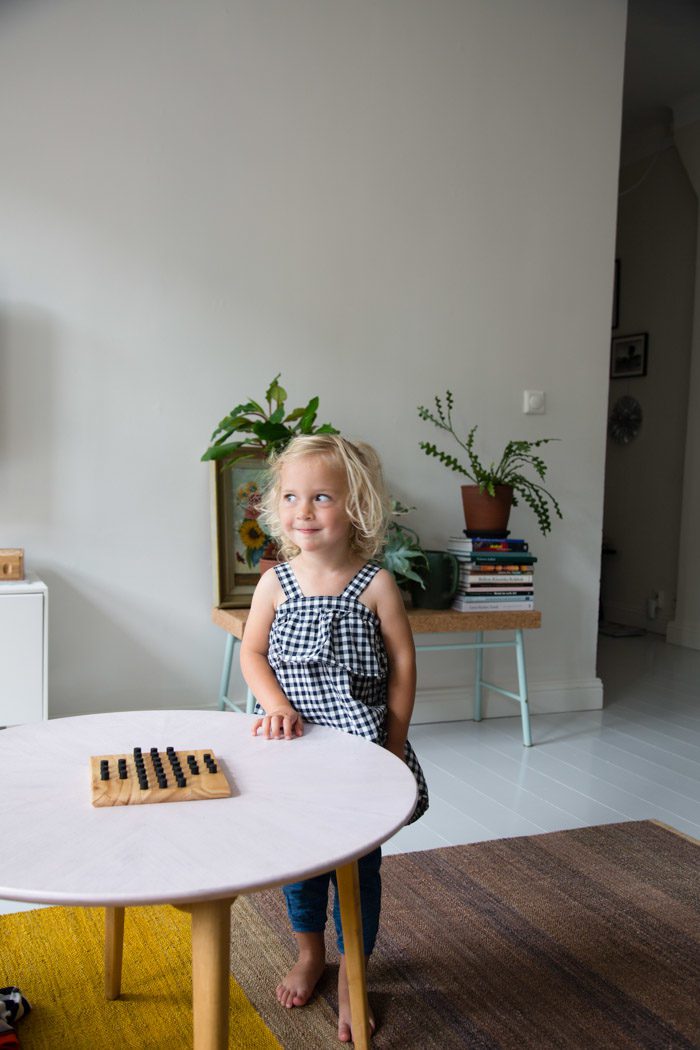
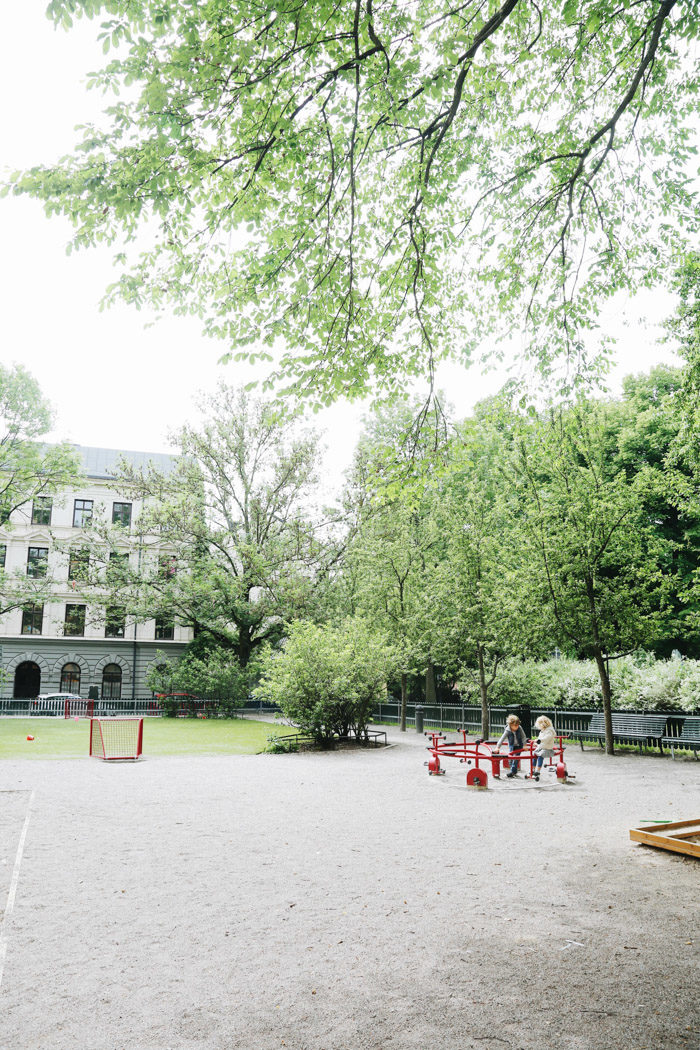
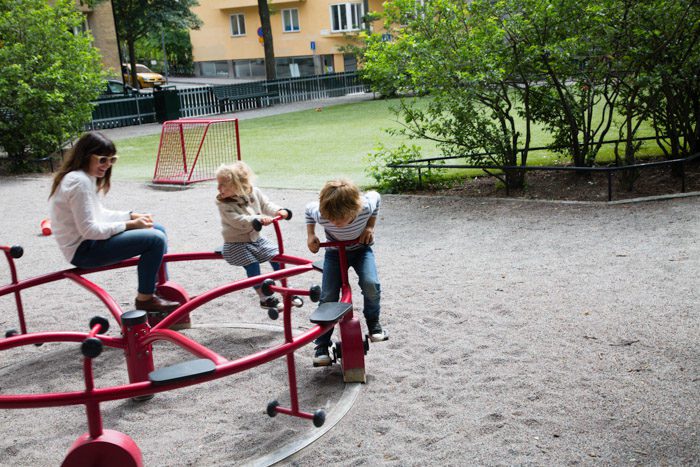
The playgrounds were wonderful and abundant. (Did I say that already?) Many had this little bicycle-powdered carousel that our kids went nuts for. We definitely need one in Davis.
Apparently, there’s also a very cool park in Söder called Bryggartäppan that is a recreation of the district in the 1800s but in miniature.
As in the states, the playgrounds were good places to strike up conversations. Aron and I both kept noting how balanced it was between moms and dads as the supervising adult.
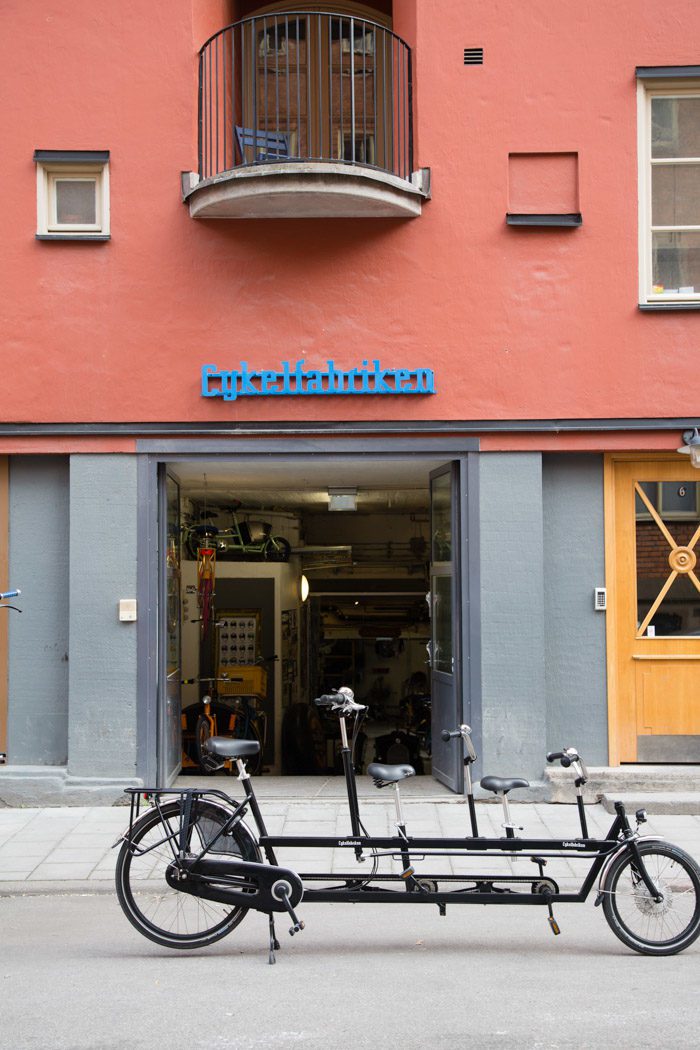
For our last day, we decided to stay close to home (so to speak) and focus on Söder. We alternated playtime at the (many) parks for them with playtime in the (many) shops for us. Some highlights:
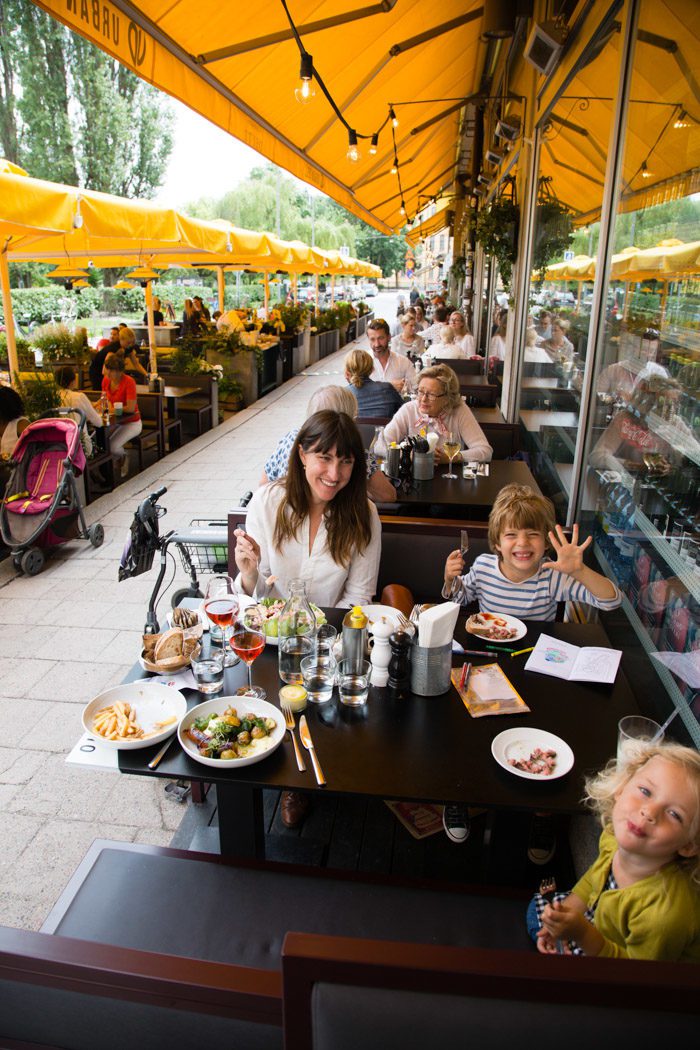
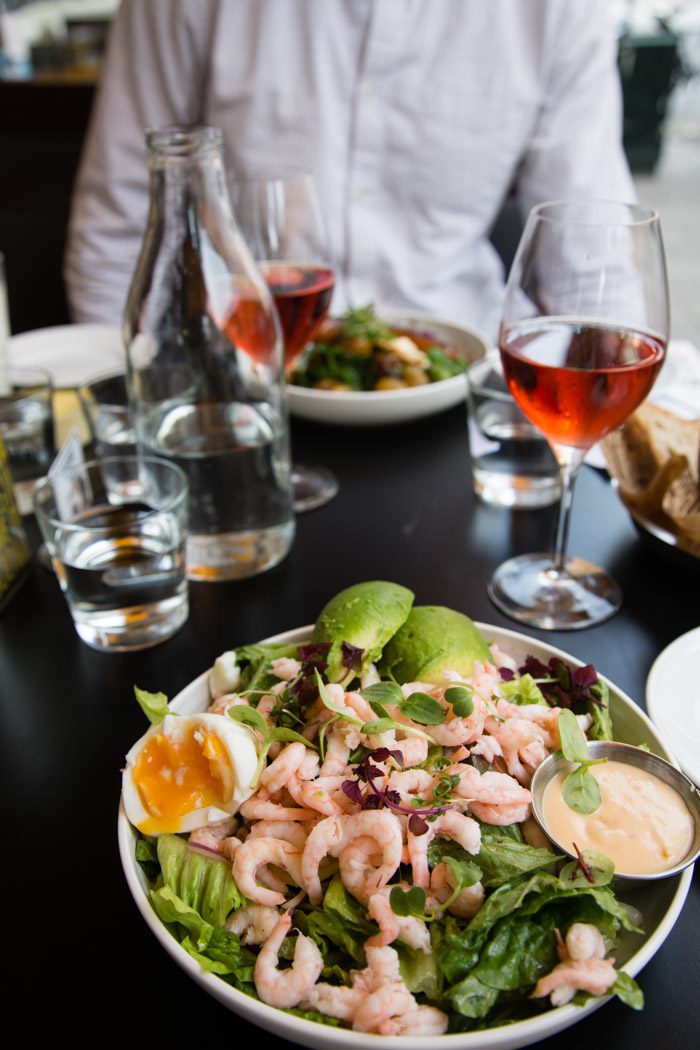
Lunch back at Urban Deli, and a Pippi book from the English Bookshop…
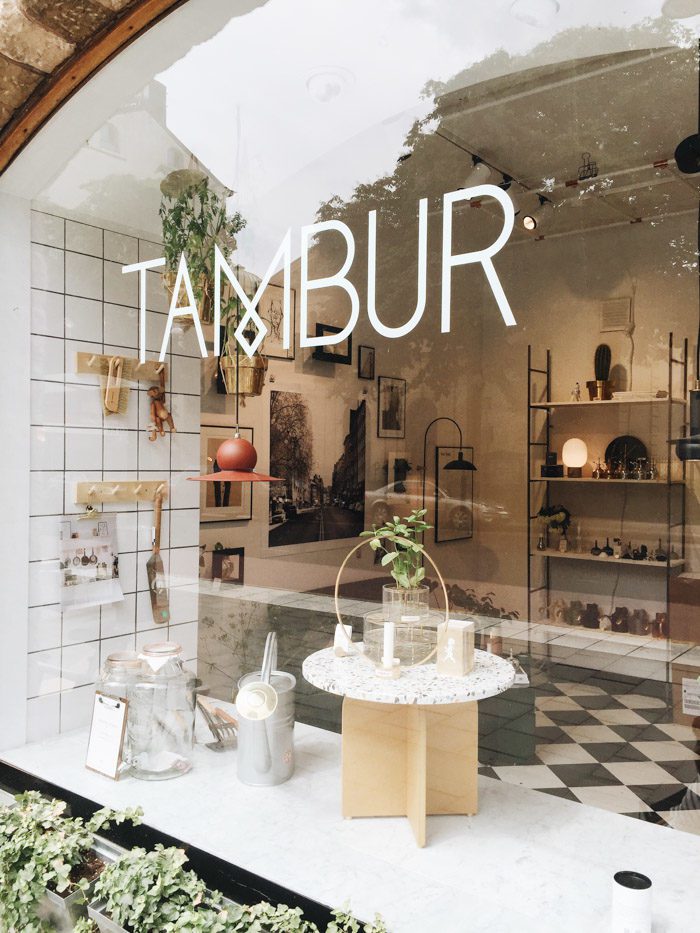
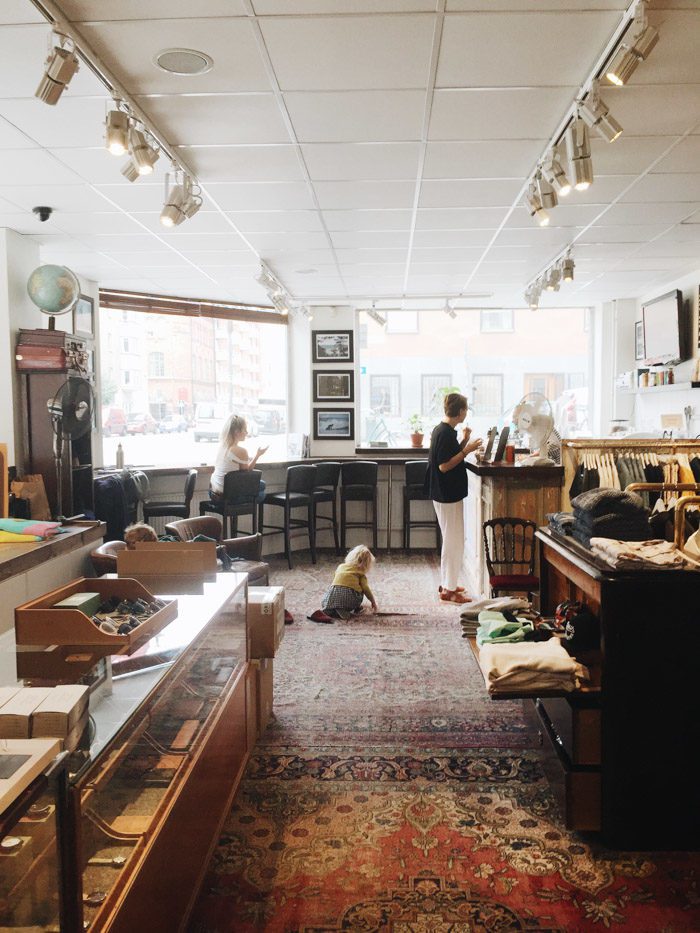
Housewares and clothing at Tambur and 6/5/4…
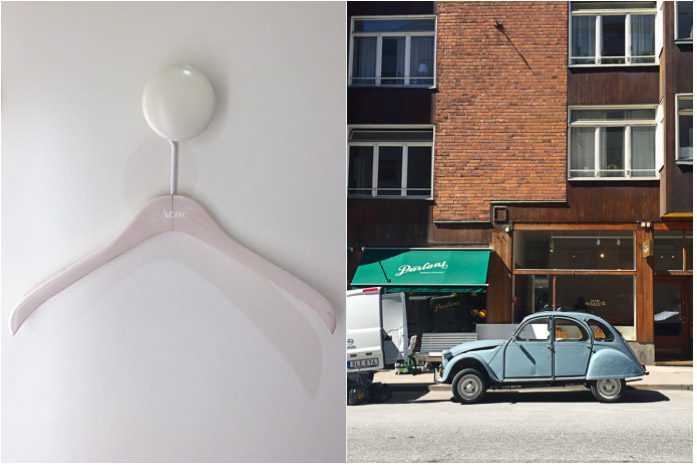

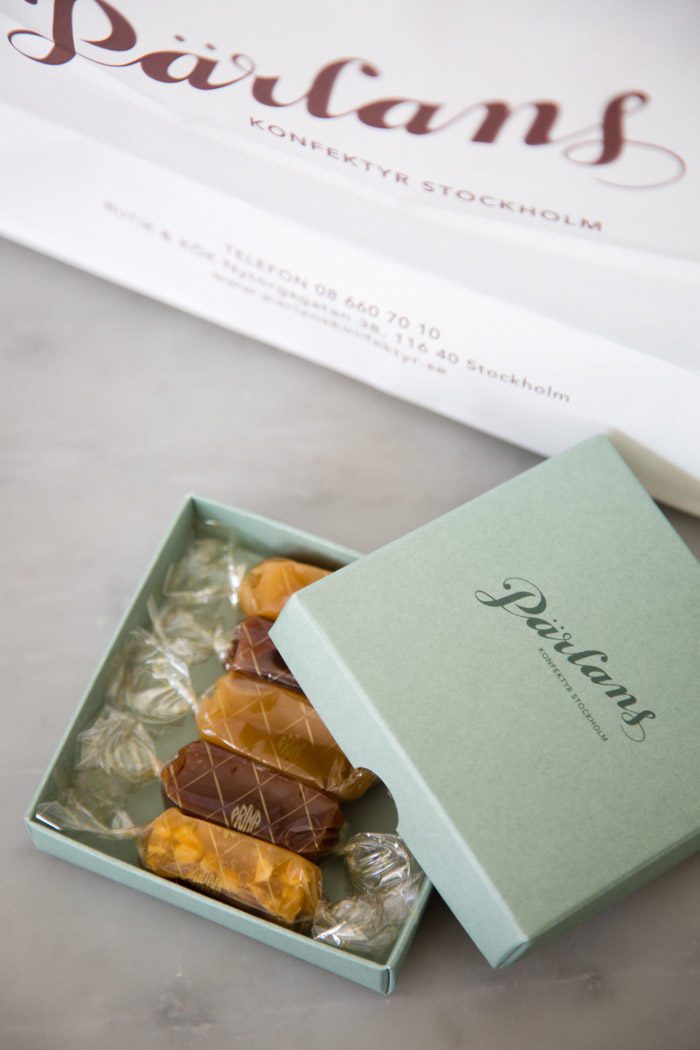
Textiles at Brita Sweden, jeans and minimal fashion at Acne Studios, stacked heels at Swedish Hasbeens, childrens’ clothes at Mini Rodini, delicious (really, really delicious) caramels at Pärlans Konfektyr…
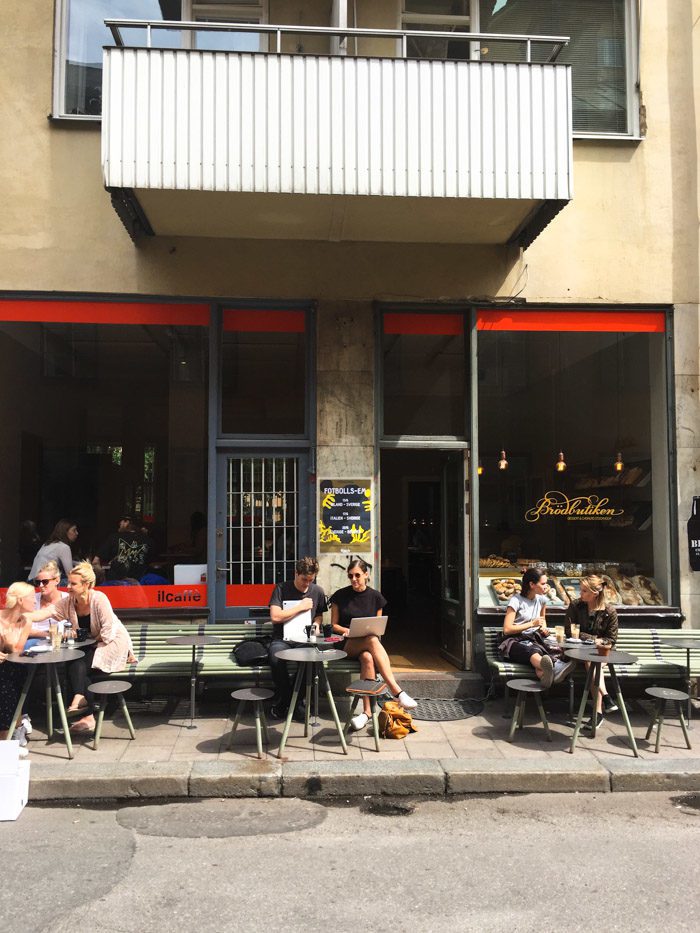
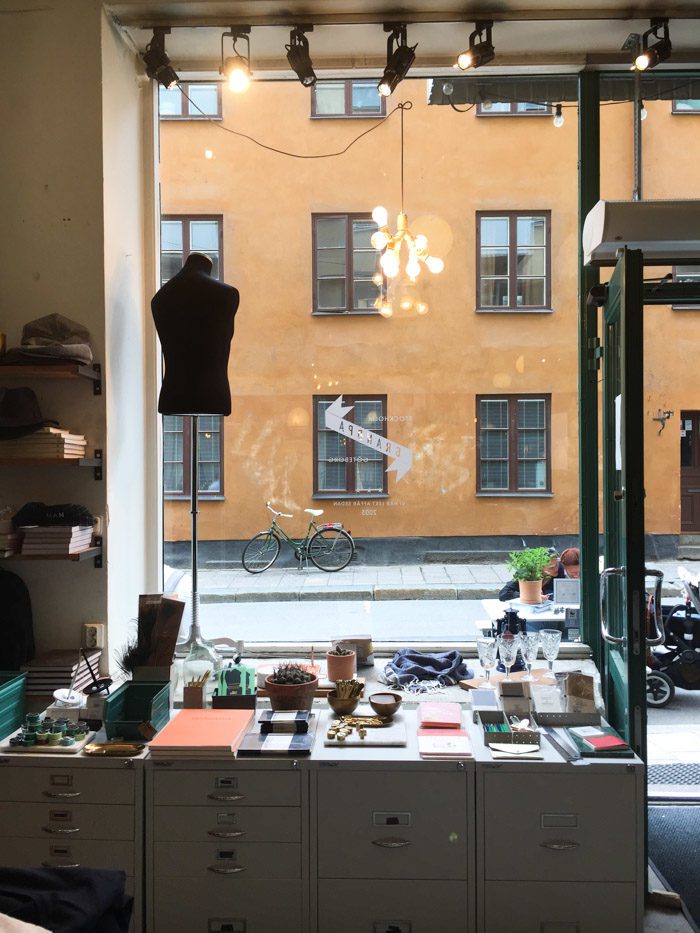
And perhaps my favorite, Grandpa, where I bought a navy jumpsuit that I’ve been wearing approximately every third day since we got home.
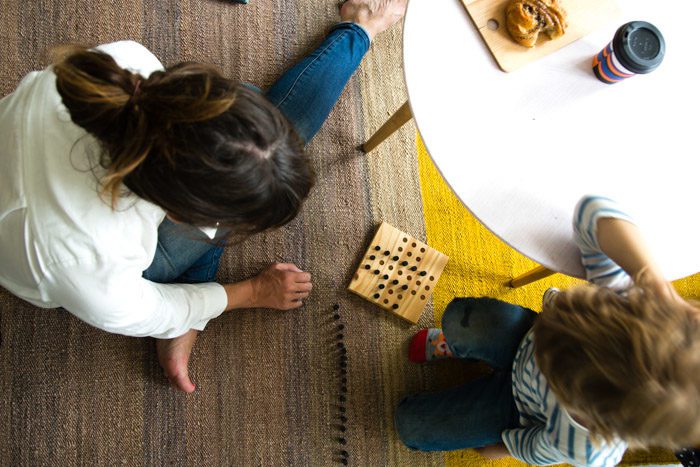
We fit in as much as we could and then went back to the apartment for an afternoon Fika break.
Some shops we missed but had hoped to visit: NK, Byredo, and Svenskt Tenn.
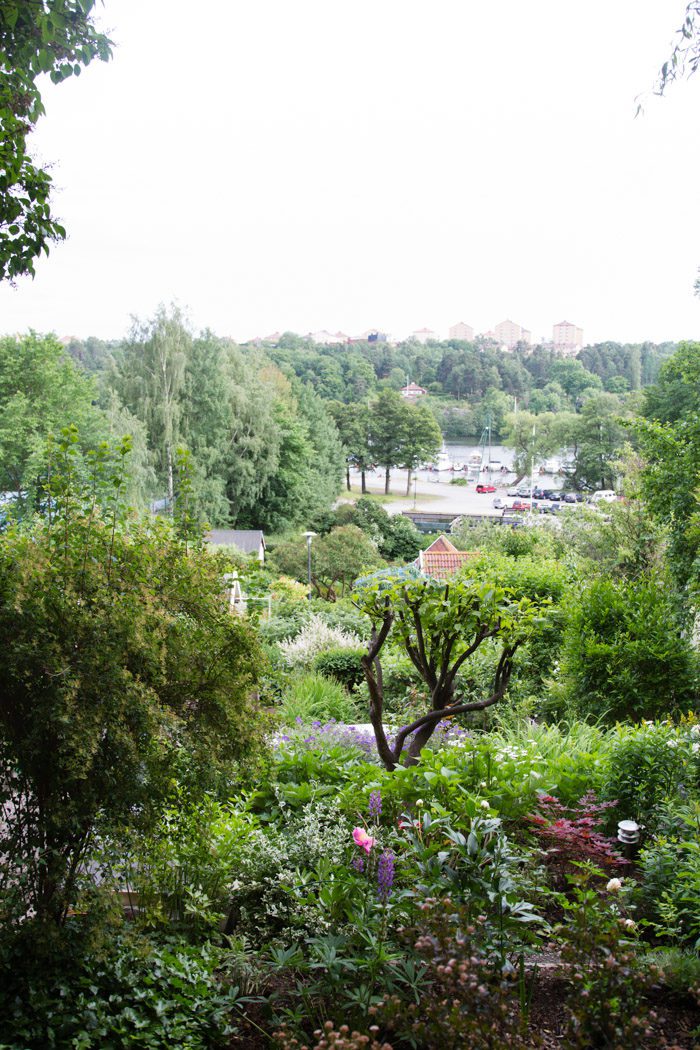
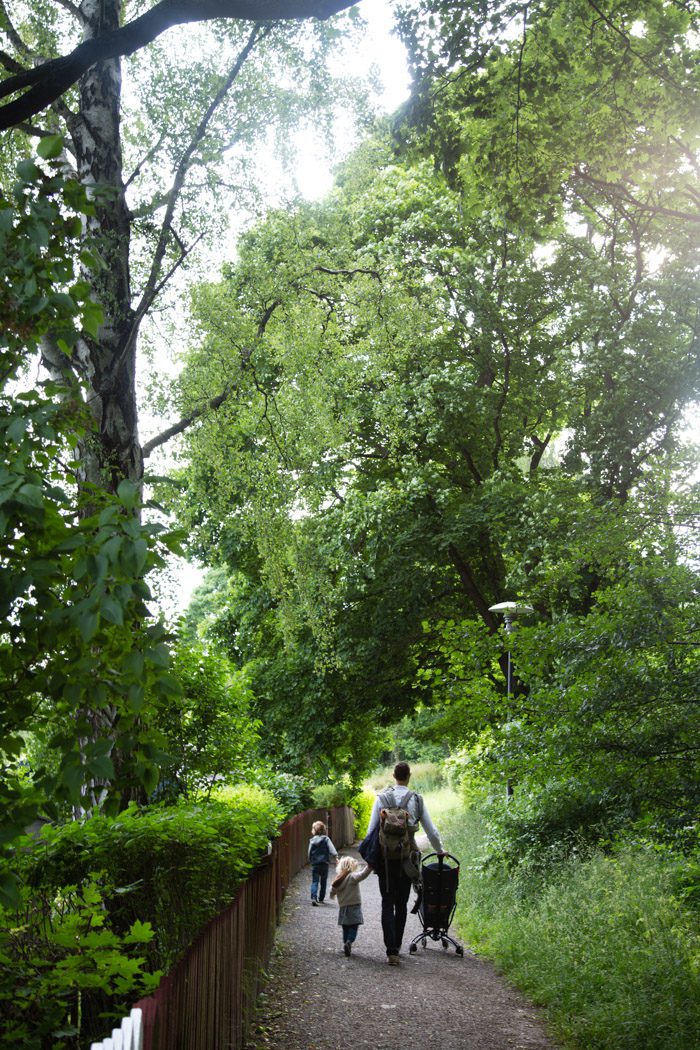
For our last evening, we followed our host’s advice and sought out a walk along the waterline of Årstaviken, a cove in the easternmost part of Lake Mälaren.
It turned out to be one of my favorite parts of our stay. Heading out to the southern edge of Söder, we got a little lost in the Ringen Centrum—where we happened upon the Teatern food court I’d read raves about—and then found ourselves out along the water, on meandering green path.
(Later, I looked back at our host’s notes and she’d suggested, in case you go: “Bring food from Reggev Hummus (if you like hummus), Delimundo (Ceviche), Falafelbaren (Falafel) or go into the less-nice-looking mall ‘Ringen’ where you in the middle will find Teatern, a really nice food court from where you can bring food or sit and eat. Of course, we neglected to do this and dealt with some panic’d hunger from the two with the tiny tummies later, but it worked out.)

A sign explained that the small homes are part of an area called Eriksdalunden where, in 1906, garden allotments were given to residents who could build 6-square-meter huts and plant various crops (only 30% of one thing at a time for diversity). Today, what was once developed for needy citizens is valuable land where the huts are surrounded by flowers, each seemingly competing with a neighbor’s for prettiest plot.
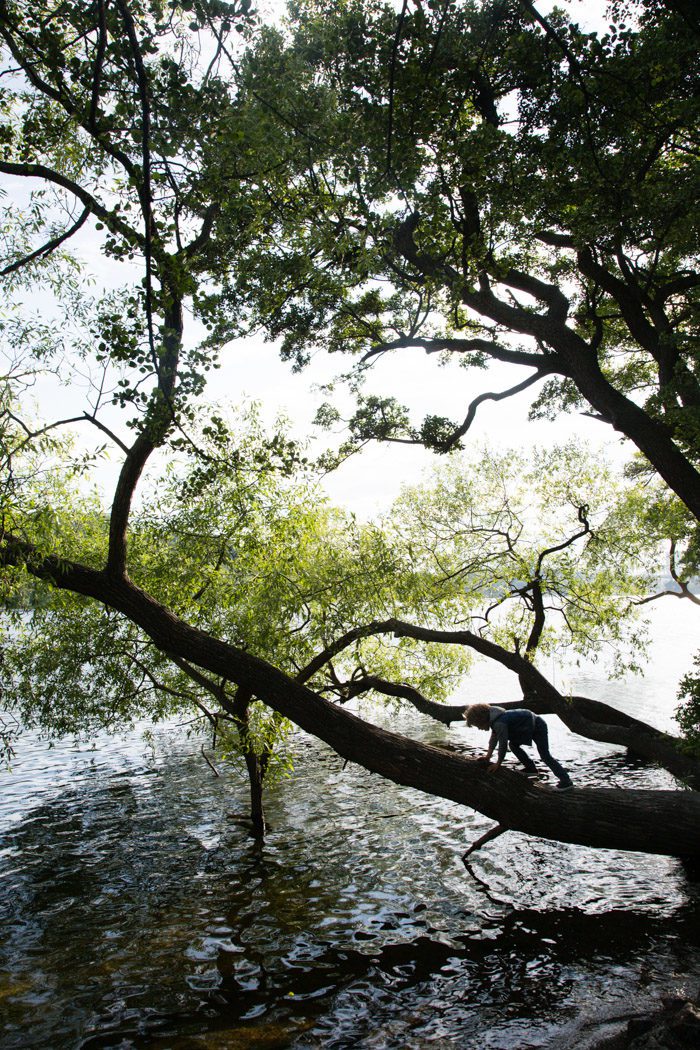
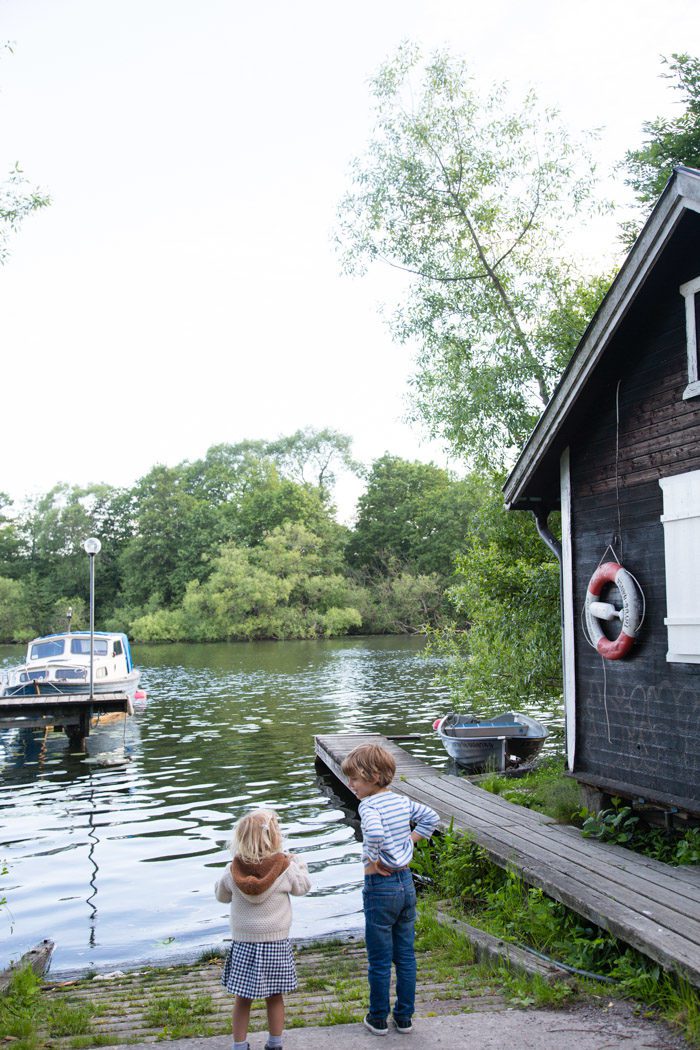

People were biking, walking, boating, swimming, and picnicking all around the lake shores.
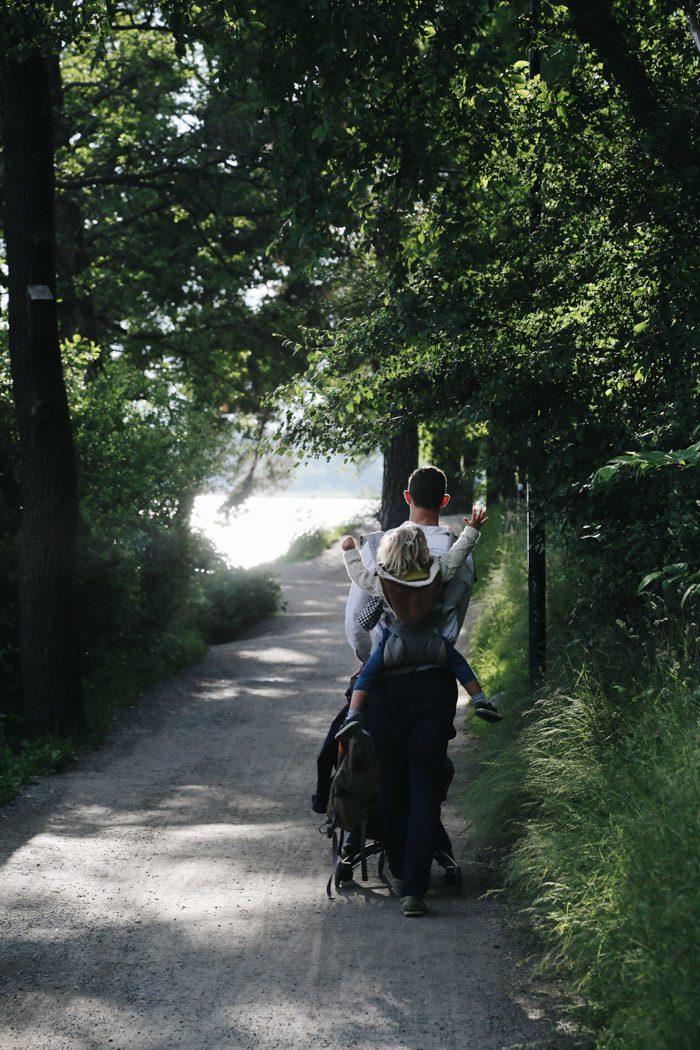
(Our last child’s last-ever ride in an Ergo. Sniff!)

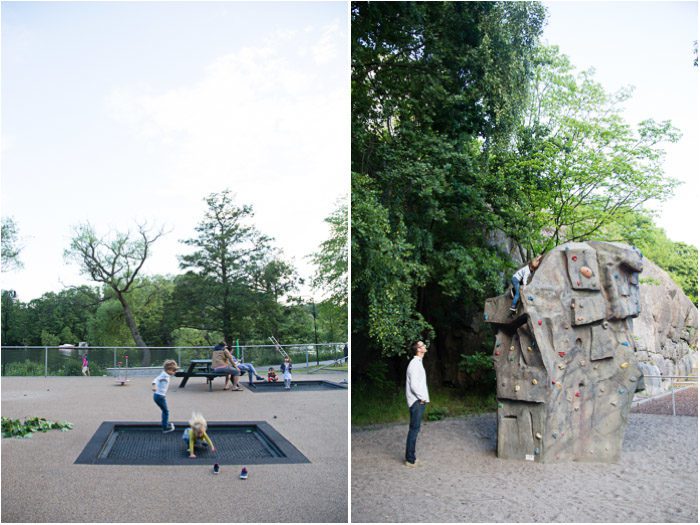
We came across a very cool looking Bocce Ball court and bar, and stopped at a playground to bounce and let Hudson climb a (by U.S. standards ridiculously dangerous) giant rock wall, and then continued on to the area of Hornstull. Barbro was the restaurant that had come recommended to us; it looked very cool, but it was packed, so we wandered a bit more until the aroma of (unfortunately mediocre) Chinese food broke our stride and we sat down. The area was very different from the waterfront we’d spent time in central Stockholm—it reminded us of Williamsburg a few years back with its slightly rougher edges—and I got the impression there was plenty more to see.
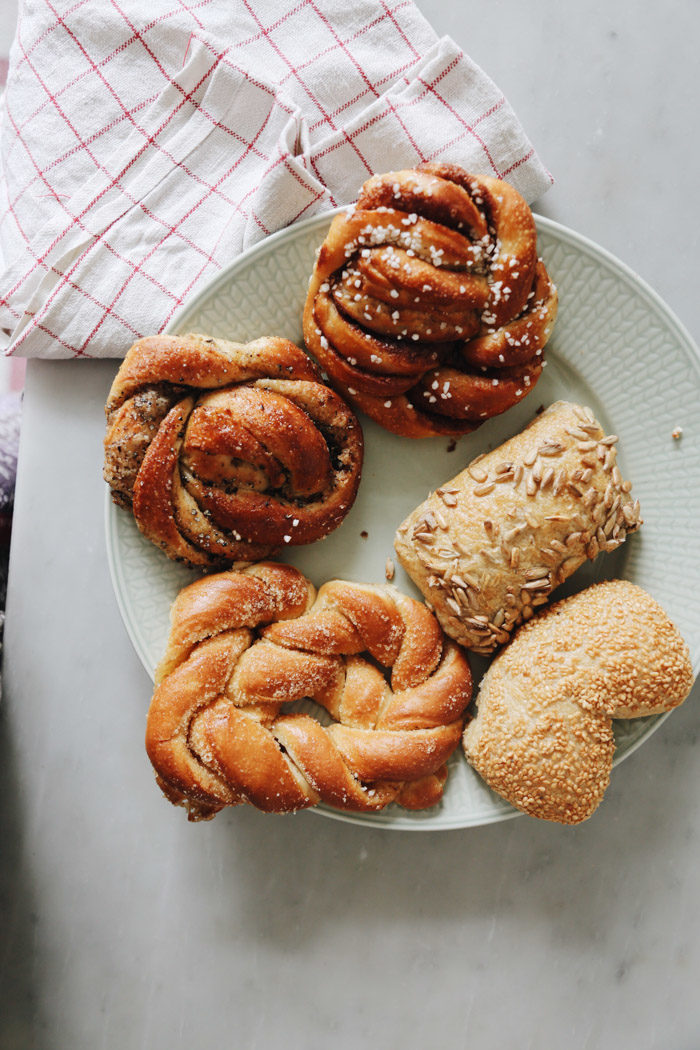
I hoped we’d one day get a chance.
For the time-being, we’d have to be content with some more delicious Kardemummabullar for the road. Next stop, Norway…
P.S. Thank you to all of you who gave suggestions for our trip in the comments of this post! I took them with me and wish we could have covered them all—a wonderful resource! Also, a few video clips at #ScandiScursion.


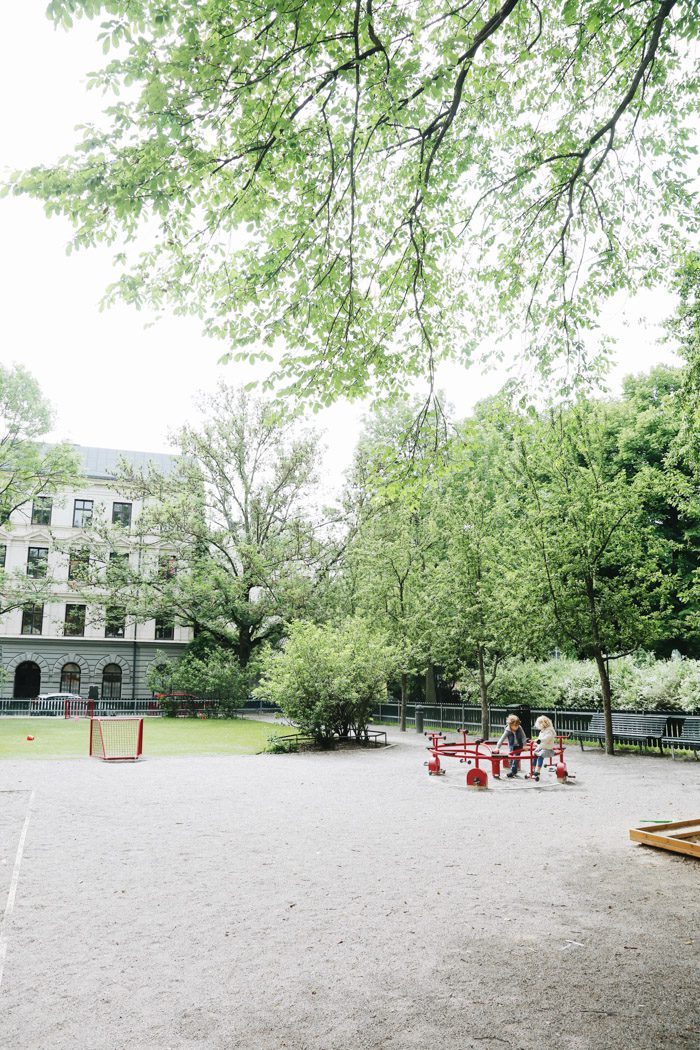
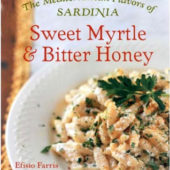
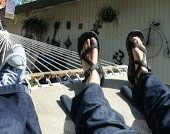











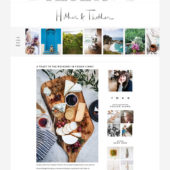
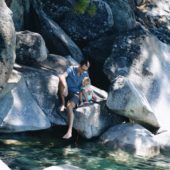




















50 Comments